Winter birds are a fascinating and diverse group that can be found throughout the state of Illinois. From migratory species that make their way south for the winter to hardy year-round residents, there are a wide variety of birds that call Illinois home during the colder months.
Some of these birds are adapted to the frigid winter temperatures, while others take advantage of the relatively mild weather to forage for food and shelter.
Whether you are an avid birder or simply interested in learning more about the feathered friends that inhabit our state, exploring the winter bird species of Illinois is an exciting and rewarding experience.
1. Northern Cardinal

The Northern Cardinal is a beautiful bird, easily identified by its bright red plumage. It can be found in the eastern United States from Maine to Minnesota and south through Mexico and Belize.
Along with its striking colouration, it has a distinctive crest on its head and sharp black facial markings around the eyes.
Despite their small size (measuring 7-9 inches) they are very vocal birds – males sing persistently throughout springtime to attract mates or proclaim their territory.
They typically feed on insects, seeds and fruits but also enjoy suet at backyard bird feeders.
The female is less brightly coloured than her mate but still stands out among other songbirds due to her warm brownish-red feathers.
Cardinals pair for life so you may often see them together in your garden or neighbourhood park.Scientific classification:
| Kingdom | Animalia |
| Phylum | Chordata |
| Class | Aves |
| Order | Passeriformes |
| Family | Cardinalidae |
| Genus | Cardinalis |
| Species | C. cardinalis |
Also Featured In: Most Common United States Birds, Birds for Your Home Garden
2. American Robin

The American robin is a migratory bird, belonging to the true thrush genus and Turdidae family.
It was named after its European counterpart due to the similar reddish-orange breast they both possess; however, they are not related closely.
This species can be seen through most of North America during winter months, as well as in parts of Mexico and Central America where it also breeds.
They have plump bodies with gray upperparts and white underparts that vary from yellow on their throats down to orange toward their bellies.
Robins feed on fruits such as berries or insects like worms which makes them an important part of ecosystems by helping disperse seeds naturally throughout these areas.Scientific classification:
| Kingdom | Animalia |
| Phylum | Chordata |
| Class | Aves |
| Order | Passeriformes |
| Family | Turdidae |
| Genus | Turdus |
| Species | T. migratorius |
Also Featured In: Flocks Birds around Us, Common Southern Californian Birds
3. American Goldfinch
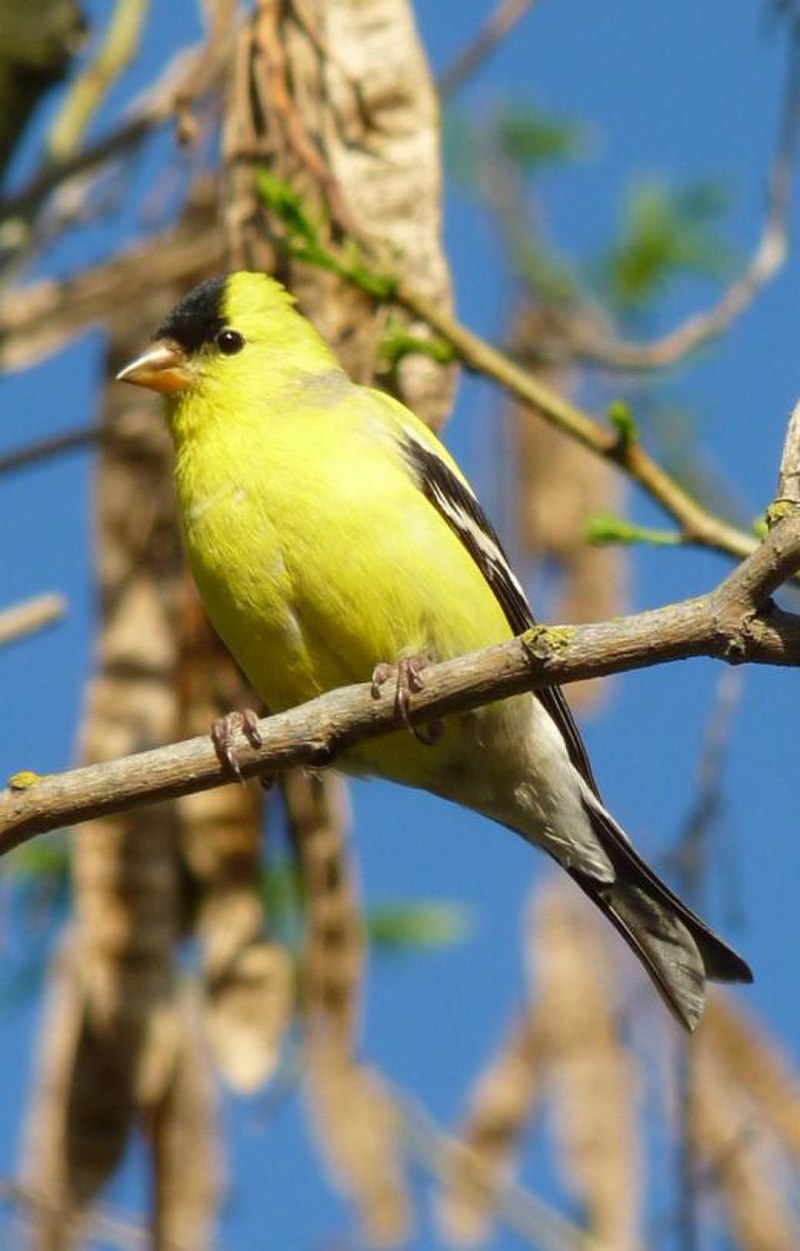
The American goldfinch is a small North American bird in the finch family. Males are vibrant yellow with black wings and tail, while females are duller in colouration.
It migrates from mid-Alberta to North Carolina during breeding season, south of Canada–United States border to Mexico for its wintering grounds.
The only finch which undergoes complete molt every year, it displays sexual dichromatism where males have brighter colours than their female counterparts.
They feed mainly on seeds but also eat insects such as aphids and caterpillars when raising youngs; they often occur near thistles or other plants that produce viable seed heads.
Their call consists of an array of chirps and trills making them quite conspicuous.Scientific classification:
| Kingdom | Animalia |
| Phylum | Chordata |
| Class | Aves |
| Order | Passeriformes |
| Family | Fringillidae |
| Subfamily | Carduelinae |
| Genus | Spinus |
| Species | S. tristis |
Also Featured In: Common Central Park Birds, Most Common Nature Birds
4. Black-Capped Chickadee

The black-capped chickadee is a small and cheerful songbird found in deciduous and mixed forests across North America. It has an iconic black cap, white cheeks, gray back and wings with whitish bars on them.
The underparts are usually light colored or greyish brown. This species is well adapted to cold winters as it can reduce its body temperature by up to 8°C while roosting at night; this helps save energy during the colder months of the year.
It feeds mainly on insects but also eats seeds, fruits and suet from bird feeders when available.
Black-capped chickadees are popular birds among backyard visitors due to their sociable nature – they often establish lifelong partnerships with one another for breeding purposes.
Furthermore, they have been designated as state birds of Massachusetts and Maine in USA plus New Brunswick in Canada – a testament to how beloved these little avian friends truly are.Scientific classification:
| Kingdom | Animalia |
| Phylum | Chordata |
| Class | Aves |
| Order | Passeriformes |
| Family | Paridae |
| Genus | Poecile |
| Species | P. atricapillus |
Also Featured In: British Columbian Birds, Black And White Birds You Don’t Know About
5. Wrens
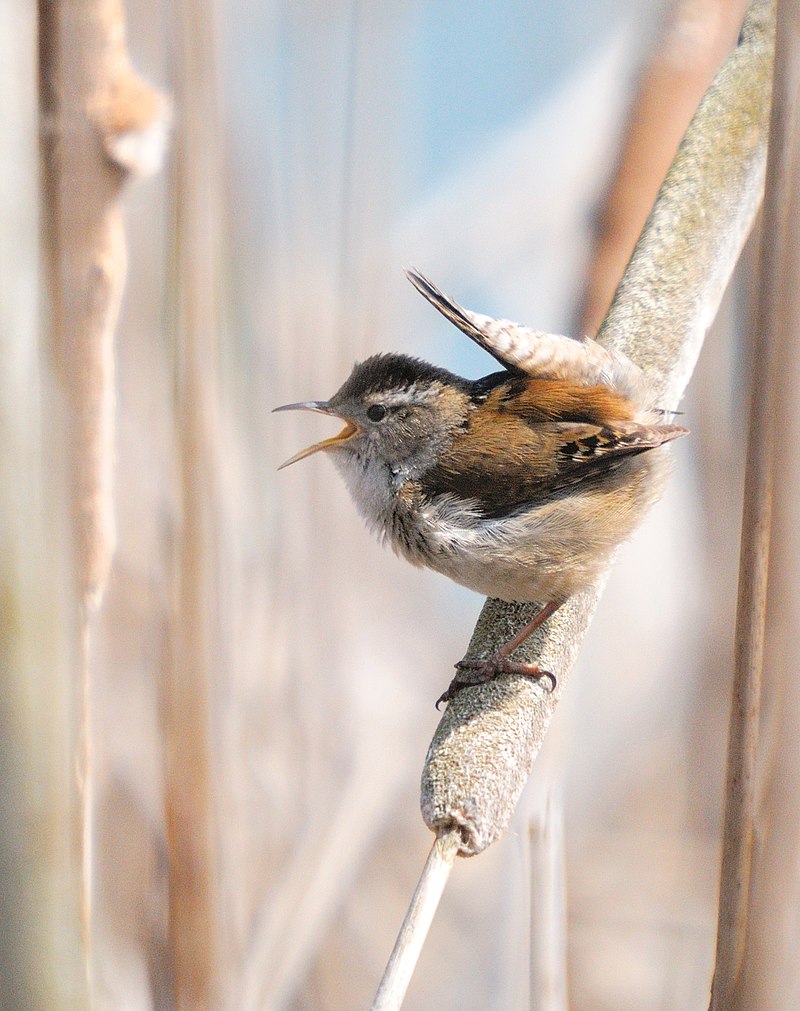
Wrens are a family of small brown passerine birds found mainly in the Americas. They are considered one of the most abundant bird species, with 88 known varieties divided into 19 genera.
The Eurasian wren is the only type that inhabits Europe and other parts of the Old World, where it’s commonly referred to simply as “wren.”
This species has been given its name due to similar-looking unrelated birds living elsewhere such as New Zealand wrasses.
Wrens have tiny bodies with thin bills and long tails which they often hold upright for hours at a time while singing their loud cheery songs from treetops or low shrubs.
Their diet consists mostly of insects but can also include fruits and seeds depending on availability in their habitat range.Scientific classification:
| Kingdom | Animalia |
| Phylum | Chordata |
| Class | Aves |
| Order | Passeriformes |
| Superfamily | Certhioidea |
| Family | Troglodytidae Swainson, 1832 |
Also Featured In: Common Denmark Birds, Most Common Scotland Birds
6. Eastern Bluebird
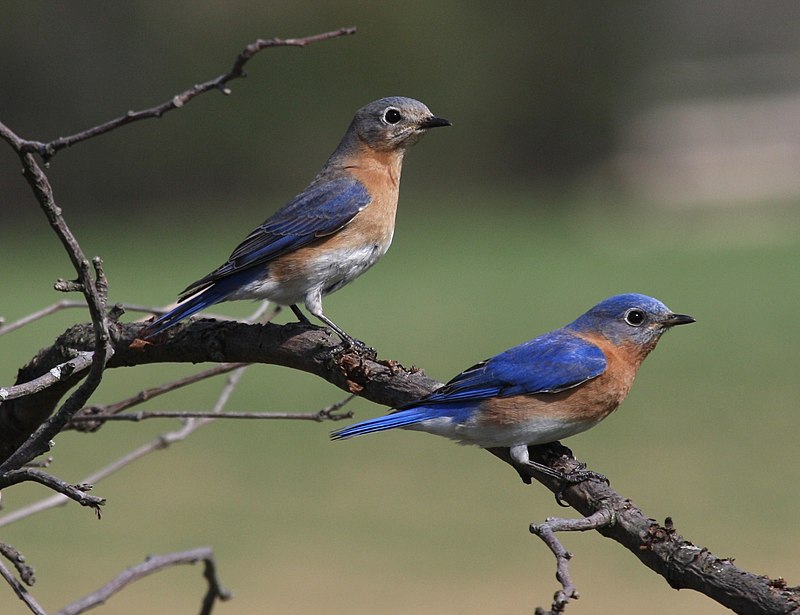
The Eastern bluebird is a small migratory thrush that can be found in open woodlands, farms and orchards across North America.
The male has bright-blue breeding plumage which makes it easily recognizable by birders.
It produces melodious songs such as jeew, chir-wi and chiti WEEW wewidoo.
This popular species was declared the state bird of Missouri back in 1927 due to its beauty and charm.
In addition to being beautiful, these birds are also beneficial for farmers because they eat insects like grasshoppers and beetles which damage crops.
They nest in cavities so providing nesting boxes helps them thrive even more.
With their vibrant colors, sweet melodies and helpful nature it’s easy to see why the Eastern Bluebird is beloved worldwide.Scientific classification:
| Kingdom | Animalia |
| Phylum | Chordata |
| Class | Aves |
| Order | Passeriformes |
| Family | Turdidae |
| Genus | Sialia |
| Species | S. sialis |
Also Featured In: House Birds You’ll Love to Pet, Birds that Live in Mississippi
7. Baltimore Oriole
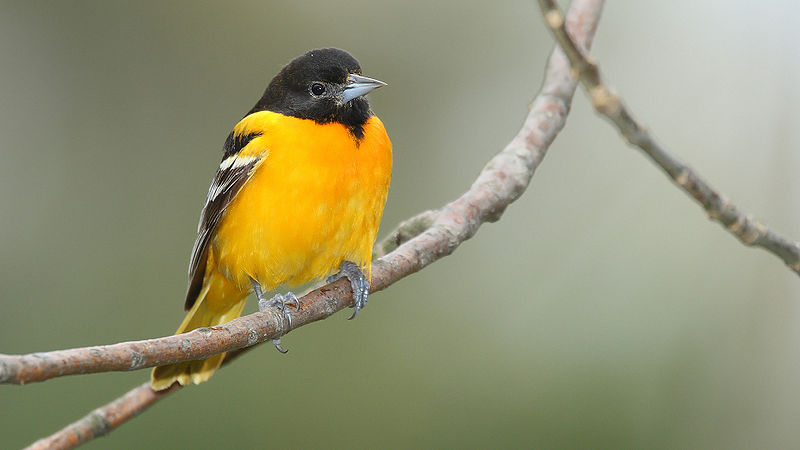
The Baltimore Oriole is a small, blackbird-like bird found in eastern North America. It’s named for the resemblance of its male colors to those on Lord Baltimore’s coat-of-arms from 17th century.
These birds migrate and breed during springtime and are quite common in their habitats.
Studies have shown that this species interbreeds with western Bullock’s orioles, leading both to be classified as a single species – Icterus galbula.
The males typically have orange feathers along the chest, back, wings and tail while females display tan or yellowish shades instead of bright orange ones like males do.
Both sexes share white wing bars and dark brown eyes which makes them easily distinguishable among other birds.
They can often be seen flitting around trees feeding off nectar buds or insects such as grasshoppers & caterpillars they catch while flying around.Scientific classification:
| Kingdom | Animalia |
| Phylum | Chordata |
| Class | Aves |
| Order | Passeriformes |
| Family | Icteridae |
| Genus | Icterus |
| Species | I. galbula |
Also Featured In: Birds that Calls in the Morning, Birds in Iowa Spring
8. Brown Thrasher
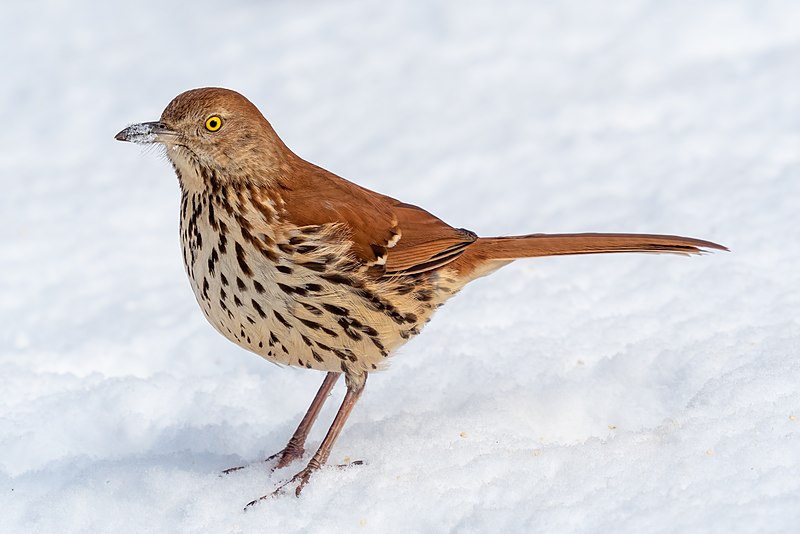
The brown thrasher is a member of the Mimidae family, along with catbirds and mockingbirds. It is found throughout much of North America in the eastern and central United States as well as southern and central Canada.
The only place that it does not inhabit is west of the Rockies or in Central Texas.
This bird can be identified by its reddish-brown back feathers, white underbelly and long tail that often drags behind it when walking on the ground hunting for food like insects, fruits or berries.
Its loud song consists of over 2000 different notes.
Brown Thrashers are known to build nests close to human activity which makes them easily accessible for observation making them a popular backyard species among many birdwatchers.Scientific classification:
| Kingdom | Animalia |
| Phylum | Chordata |
| Class | Aves |
| Order | Passeriformes |
| Family | Mimidae |
| Genus | Toxostoma |
| Species | T. rufum |
Also Featured In: Brown Birds that Live in West Virginia, Brown Birds that are Found in Mississippi
9. Common Loon
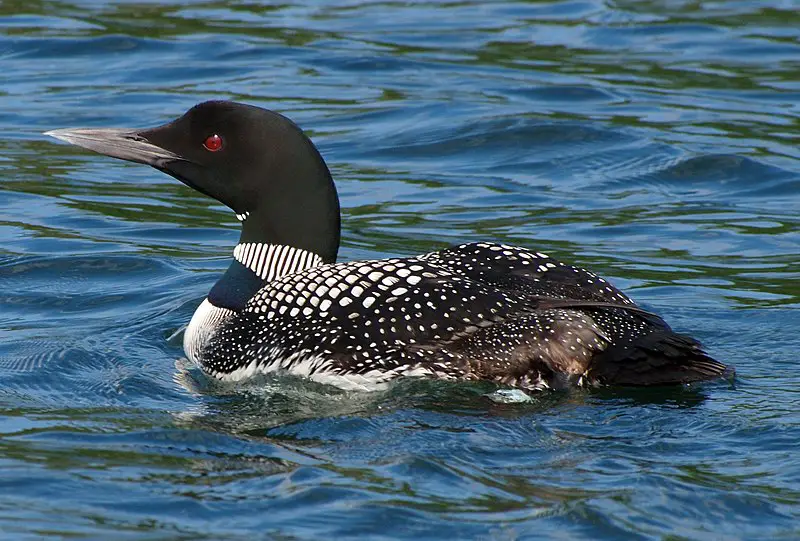
The Common Loon is a beautiful bird found in North America. It has a large black head and neck, with a greenish to purple sheen that stands out against its dark grey upperparts.
The underparts are pure white except for some black on the undertail coverts and vent.
During non-breeding season adults have brown plumage instead of the bright shades they show during breeding season.
They also exhibit unique behaviors such as diving underwater to catch fish or swimming along lakeshores while calling loudly, which is how they got their name “great northern diver”.
With their stunning colors and interesting behavior, it’s no wonder why these birds make up an iconic part of many landscapes across North America.Scientific classification:
| Kingdom | Animalia |
| Phylum | Chordata |
| Class | Aves |
| Order | Gaviiformes |
| Family | Gaviidae |
| Genus | Gavia |
| Species | G. immer |
Also Featured In: Water Birds Live around Us, Shetland Islands Birds You Should Know
10. Blue Jay

The Blue Jay is a beautiful bird that resides in eastern and central United States, as well as Newfoundland Canada.
They have an unmistakable blue colored plumage with white markings on their heads and wings.
These birds are highly adaptable to different habitats ranging from deciduous forests to urban areas.
As part of the Corvidae family, they are known for being intelligent problem solvers who will often use tools or mimic vocalizations of other species like hawks when defending their territories.
Their diet consists mostly of insects, seeds and nuts but can also include small vertebrates such as frogs or lizards if food resources become scarce.
Overall these birds provide much needed color to our environment while playing important roles in maintaining healthy ecosystems through pollination services and seed dispersal activities.Scientific classification:
| Kingdom | Animalia |
| Phylum | Chordata |
| Class | Aves |
| Order | Passeriformes |
| Family | Corvidae |
| Genus | Cyanocitta |
| Species | C. cristata |
Also Featured In: Birds of Nova Scotia, Birds of Symbolism
11. Bald Eagle
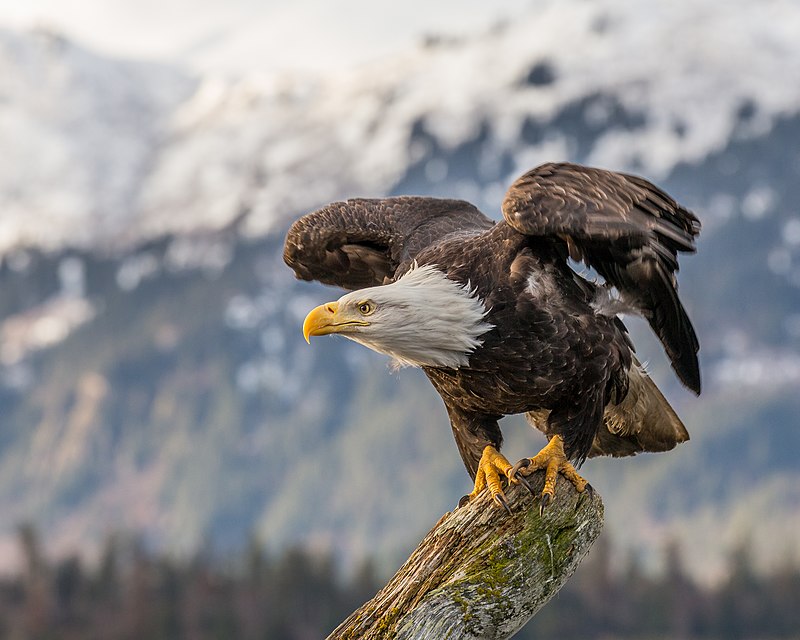
The majestic Bald Eagle is a bird of prey found in North America and recognized as the national symbol of the United States.
With its distinctive white head, brown body and striking yellow beak, this sea eagle has two known subspecies that form a species pair with the White-tailed Eagle.
It inhabits much of Canada, Alaska all states in the US contiguous area and Northern Mexico near large bodies of water where they feed mainly on fish.
These birds have an impressive wingspan ranging from 1.8 to 2 meters depending on their size making them one of nature’s most magnificent creatures.Scientific classification:
| Kingdom | Animalia |
| Phylum | Chordata |
| Class | Aves |
| Order | Accipitriformes |
| Family | Accipitridae |
| Genus | Haliaeetus |
| Species | H. leucocephalus |
Also Featured In: Flight Birds You Should Know, Birds You’ll Find in Zoo
12. Downy Woodpecker
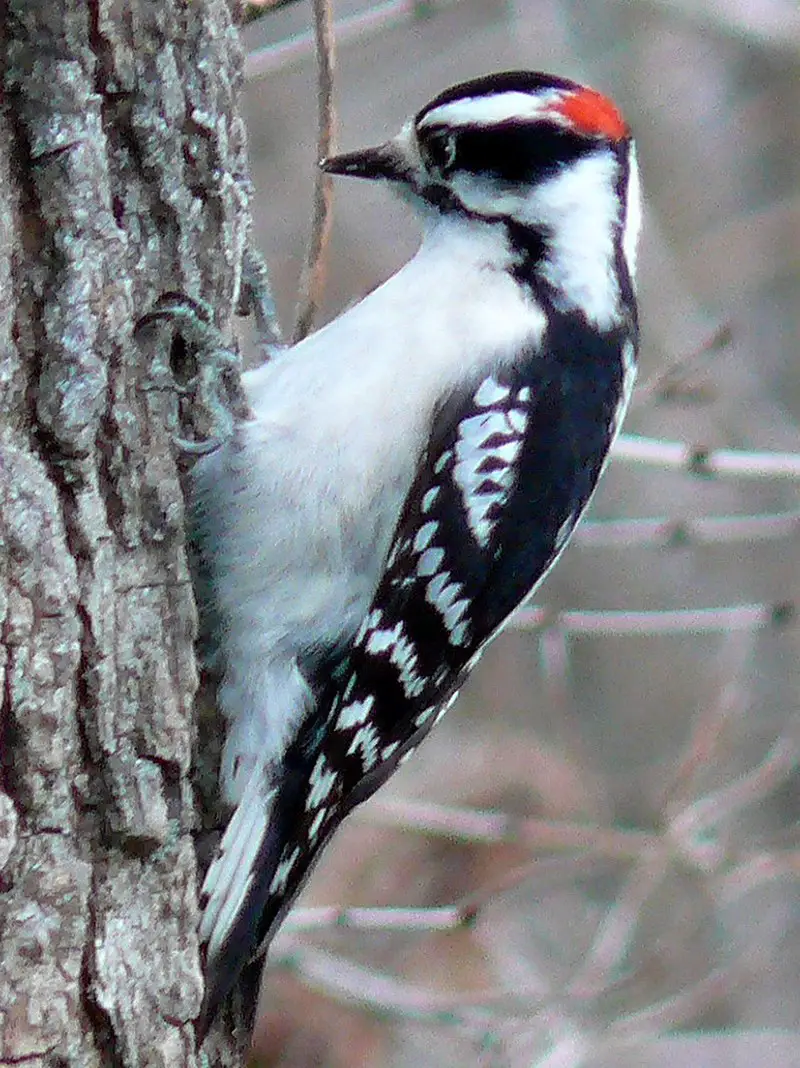
The downy woodpecker is a small species of woodpecker found in North America. Growing up to 7 inches long, it can be identified by its white belly and spotted wings.
It inhabits forests throughout the United States and Canada, with the exception of deserts in the southwest and northern tundra.
This bird nests in tree cavities and feeds mostly on insects but will supplement its diet with fruit or nuts when available.
The Downy Woodpecker has an unmistakable call that sounds like a loud ‘pik-er’, similar to other members of its family such as the Hairy Woodpecker.Scientific classification:
| Kingdom | Animalia |
| Phylum | Chordata |
| Class | Aves |
| Order | Piciformes |
| Family | Picidae |
| Genus | Dryobates |
| Species | D. pubescens |
Also Featured In: Long Island Birds You Should Know, Birds in Pacific Northwest
13. American Crow

The American crow is a large bird of the Corvidae family, native to most parts of North America.
It is similar in size and structure to its European counterpart, the carrion crow, as well as Eurasia’s hooded crow.
The three species occupy the same ecological niche, but are distinguishable by their differences in appearance.
American crows have black feathers covering their entire body with wingspan averaging between 17-21 inches wide for males and 16-19 inches for females.
They feed on insects such as grasshoppers, beetles and caterpillars; they also eat grains from fields or abandoned farms during winter months when food sources become scarcer.
In addition to feeding habits American crows can be identified by their distinct call which resembles a “caw” sound that travels long distances over open terrain making them popular among birdwatchers.Scientific classification:
| Kingdom | Animalia |
| Phylum | Chordata |
| Class | Aves |
| Order | Passeriformes |
| Family | Corvidae |
| Genus | Corvus |
| Species | C. brachyrhynchos |
Also Featured In: Birds Live Near San Diego, Birds that Live in San Francisco Bay Area
14. House Sparrow

The house sparrow is a small bird of the Passeridae family. It has an average length of 16 cm and weighs 24-39.5 gm.
Females have dull brown and grey plumage, whereas males are brighter, with black, white and brown markings on their wings and back feathers.
This species is one among 25 different kinds in its genus Passer .These birds are found all around the world mainly near human dwellings where they feed off food scraps from garbage bins or gardens etc..
They also make nests close to houses which makes them even more visible to people living nearby.
House sparrows can be seen hopping around yards looking for food during daytime hours but usually hide in colonies at night time.Scientific classification:
| Kingdom | Animalia |
| Phylum | Chordata |
| Class | Aves |
| Order | Passeriformes |
| Family | Passeridae |
| Genus | Passer |
| Species | P. domesticus |
Also Featured In: Asian Birds, European Birds
15. Red-Bellied Woodpecker
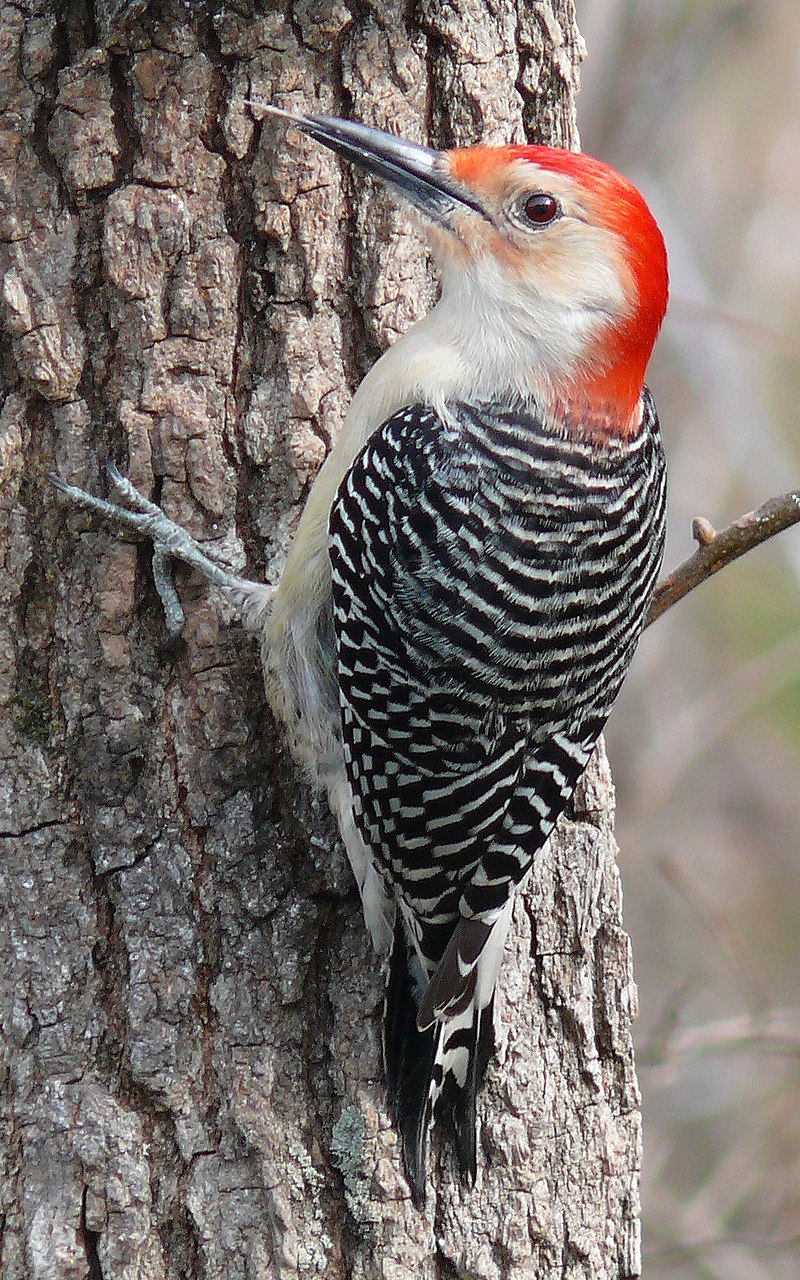
The Red-bellied woodpecker is a beautiful bird with an orange-red crown and nape. It breeds mainly in the eastern United States, ranging from Florida to Canada.
This medium-sized woodpecker of the family Picidae has black wings, white stripes on its back and tail feathers that are barred with black.
Its underside is mostly pale yellow or white but it also features some red coloration around its neck area.
Despite this subtle red hue, it should not be mistaken for the entirely red head and neck belonging to the Red-headed woodpecker of the same genus Melanerpes carolinus.
The Red bellied Woodpeckers diet consists primarily of insects such as ants, beetles and grasshoppers along with nuts fruits berries and tree sap which they will feed upon during different times throughout their life cycle.Scientific classification:
| Kingdom | Animalia |
| Phylum | Chordata |
| Class | Aves |
| Order | Piciformes |
| Family | Picidae |
| Genus | Melanerpes |
| Species | M. carolinus |
Also Featured In: Common Birds of Houston, Red Birds You’ll See in Oklahoma
16. House Finch

The House Finch is a species of finch native to western North America and has been introduced in the eastern half of the continent as well as Hawaii.
It’s an average-sized finch with adults measuring 12.5 – 15 cm (5 – 6 inches) long and having wingspans between 20 – 25 cm (8 – 10 inches).
The upperparts are brown, while its underparts range from pale grayish white to yellow depending on subspecies.
Its face is streaked or spotted with reddish coloration; males typically have brighter plumage than females due to sexual dimorphism.
They’re mostly found near human habitations such as farms and gardens where they feed on grains, fruits, insects etc., making them very popular among birders who want something colorful for their backyard.Scientific classification:
| Kingdom | Animalia |
| Phylum | Chordata |
| Class | Aves |
| Order | Passeriformes |
| Family | Fringillidae |
| Subfamily | Carduelinae |
| Genus | Haemorhous |
| Species | H. mexicanus |
Also Featured In: Common Birds That Live in Las Vegas, Birds That Live around Seattle
17. Dark-Eyed Junco

The Dark-eyed Junco is a species of small, grayish sparrows that are found across much of temperate North America and in the Arctic during summer.
It was formally described by Carl Linnaeus in 1766, who named it after its distinctive dark eyes.
This bird has a very variable appearance due to the many different subspecies it contains, making its systematics difficult to unravel.
The plumage varies from white or light gray on their underparts with slate grey backs and wings; black heads with white outer tail feathers; brown head stripes; yellow bills; pink legs and feet; as well as various shades between all these colours.
They also have considerable sexual dimorphism where males tend to be more colourful than females but share similar characteristics such as short tails and rounded bodies – both sexes being around 16 cm long when fully grown.Scientific classification:
| Kingdom | Animalia |
| Phylum | Chordata |
| Class | Aves |
| Order | Passeriformes |
| Family | Passerellidae |
| Genus | Junco |
| Species | J. hyemalis |
Also Featured In: Lake Tahoe Birds, Birds that Live in Vancouver
18. Common Starling

The Common Starling is a medium-sized passerine bird that belongs to the starling family. It has glossy black plumage with a metallic sheen, and in certain times of year it can be speckled with white.
The bill and legs are typically pink or black depending on the season, while its length measures about 8 inches long.
Its diet consists mainly of insects but also includes small fruits and seeds as well as some human food waste.
They live in large flocks which provides protection against predators, although they can become quite aggressive when defending their nesting sites during breeding seasons.
Overall, this species is highly adaptable and widely distributed across many parts of Europe making them one of the most successful birds in the region today.Scientific classification:
| Kingdom | Animalia |
| Phylum | Chordata |
| Class | Aves |
| Order | Passeriformes |
| Family | Sturnidae |
| Genus | Sturnus |
| Species | S. vulgaris |
Also Featured In: Common Species of Birds, Yellow Connecticut Birds
19. Mourning Dove
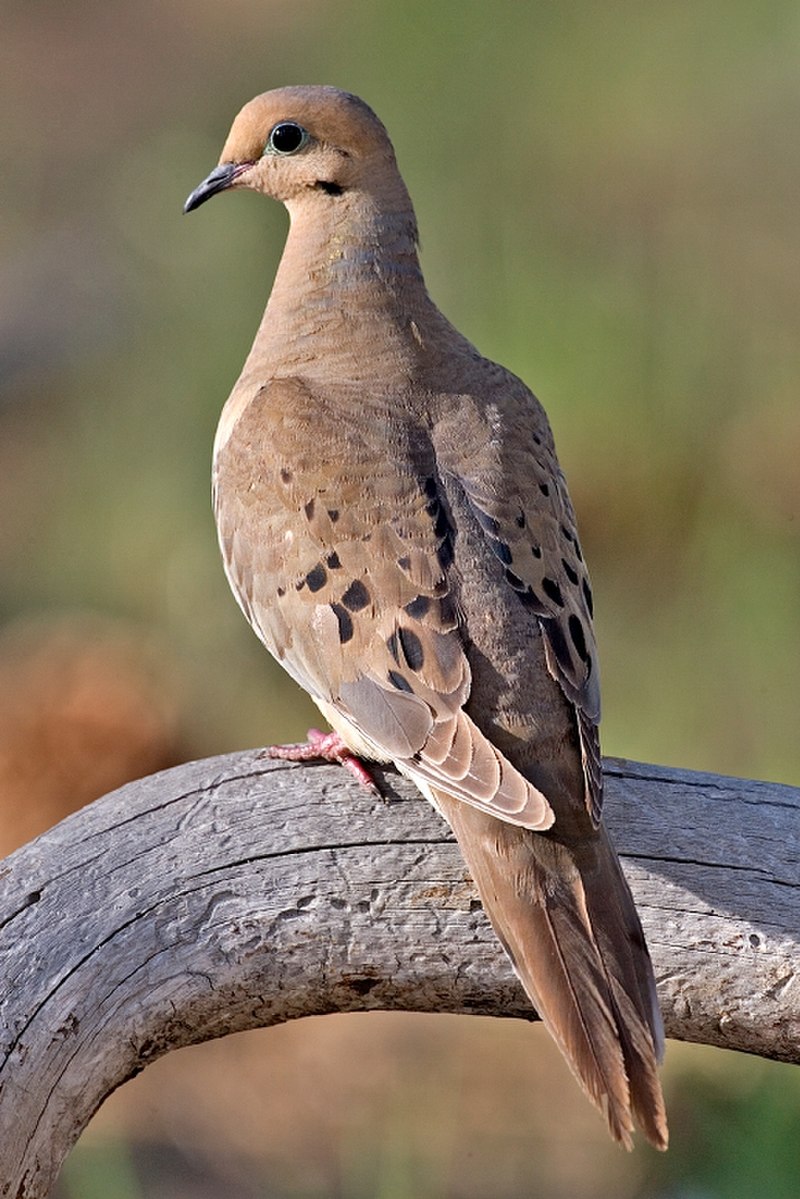
The Mourning Dove is a breathtakingly beautiful bird. It has stunning gray and brown feathers with white tipped wings, giving it an elegant appearance. Its long tail also adds to its graceful look in flight.
A symbol of peace and serenity, they are abundant across North America and can be found in gardens or open fields throughout the year.
As well as being popular game birds for hunters, they feed on grains such as wheat and millet providing important food sources for wildlife species including foxes, coyotes, skunks and raccoons.
These doves have a distinctive cooing sound that can often be heard echoing through woodlands during summer evenings making them one of nature’s greatest treasures.Scientific classification:
| Kingdom | Animalia |
| Phylum | Chordata |
| Class | Aves |
| Order | Columbiformes |
| Family | Columbidae |
| Genus | Zenaida |
| Species | Z. macroura |
Also Featured In: Small Kentucky Birds, Brown Tennessee Birds
20. Tufted Titmouse

The Tufted Titmouse is a small, cheerful songbird found in North America. It’s part of the tit and chickadee family (Paridae).
It has distinctive white feathers around its eyes, grey-brown wings and upper body, with a pale tan underside.
Its most notable feature is the black crest on top of its head that gives it an inquisitive look. The male also sports a pinkish breast which can be seen.
When singing from high perches during the spring months. This bird loves to eat sunflower seeds or suet at backyard feeders as well as insects in summertime.
You may even see them poking into crevices and bark looking for food.
They are quite social birds too, being often spotted in mixed flocks alongside other species such as nuthatches and woodpeckers all year round.Scientific classification:
| Kingdom | Animalia |
| Phylum | Chordata |
| Class | Aves |
| Order | Passeriformes |
| Family | Paridae |
| Genus | Baeolophus |
| Species | B. bicolor |
Also Featured In: Small Birds that Live in Washington D.C., Common Vermont Winter Birds
21. White-Breasted Nuthatch

The White-breasted Nuthatch is a medium-sized bird belonging to the nuthatch family Sittidae. It measures around 15.5 cm in length and its colour varies throughout its range.
Males have a light blue-grey upperpart, with black crown and nape whereas females have a dark grey crown instead of black one.
The underparts are whitish, with reddish tinge on sides and flanks while the bill is short and stout with pale base near eyes which can be yellow or white depending upon geographic location..
This species feeds mainly on insects but will also eat seeds, nuts and berries when available.
They prefer open woodlands where they often climb trees searching for food along trunks as well as branches underneath bark crevices creating their nest there too.Scientific classification:
| Kingdom | Animalia |
| Phylum | Chordata |
| Class | Aves |
| Order | Passeriformes |
| Family | Sittidae |
| Genus | Sitta |
| Species | S. carolinensis |
Also Featured In: Birds Commonly Found in Northern California, Large Birds Live in Idaho
22. Red-Winged Blackbird

The red-winged blackbird is a beautiful bird found in most of North America and Central America.
Its distinct features include a glossy black body, with white shoulder patches and bright red wing coverts year round.
It prefers wetland habitats such as marshes, ponds, lakeshores and agricultural fields. During breeding season they inhabit grassy areas near water then move south for the winter months.
For food they mainly eat insects but also consume wild fruit or grains.
They are very social birds often seen in large flocks during migration times when their unmistakable “conk-la-ree” call can be heard echoing across the sky.Scientific classification:
| Kingdom | Animalia |
| Phylum | Chordata |
| Class | Aves |
| Order | Passeriformes |
| Family | Icteridae |
| Genus | Agelaius |
| Species | A. phoeniceus |
Also Featured In: Wetlands Birds You Should Know, Red birds You’ll See in Arizona
23. Carolina Wren
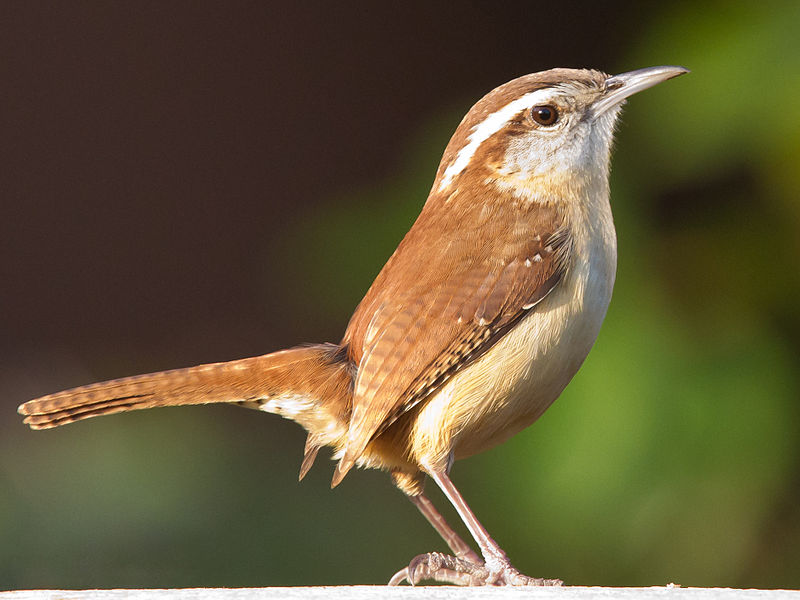
The Carolina wren (Thryothorus ludovicianus) is a medium-sized bird that can be found in the eastern United States, southern Ontario and northeast Mexico.
They typically live in dense shrubbery or thickets near open areas such as gardens, parks and woodland edges.
These birds are quite adaptable when it comes to nesting sites – they will build their nests anywhere from tree cavities to manmade boxes.
Their diet consists of insects, spiders and other invertebrates which they forage for on the ground or among vegetation.
The males have an unmistakable song made up of loud whistles interspersed with trills reminiscent of laughter; you’ll often find these cheerful little birds singing away during early morning hours.Scientific classification:
| Kingdom | Animalia |
| Phylum | Chordata |
| Class | Aves |
| Order | Passeriformes |
| Family | Troglodytidae |
| Genus | Thryothorus Vieillot, 1816[2] |
| Species | T. ludovicianus |
Also Featured In: Birds that can be Seen in Outer Banks, Small Birds Live in Vermont
24. Belted Kingfisher
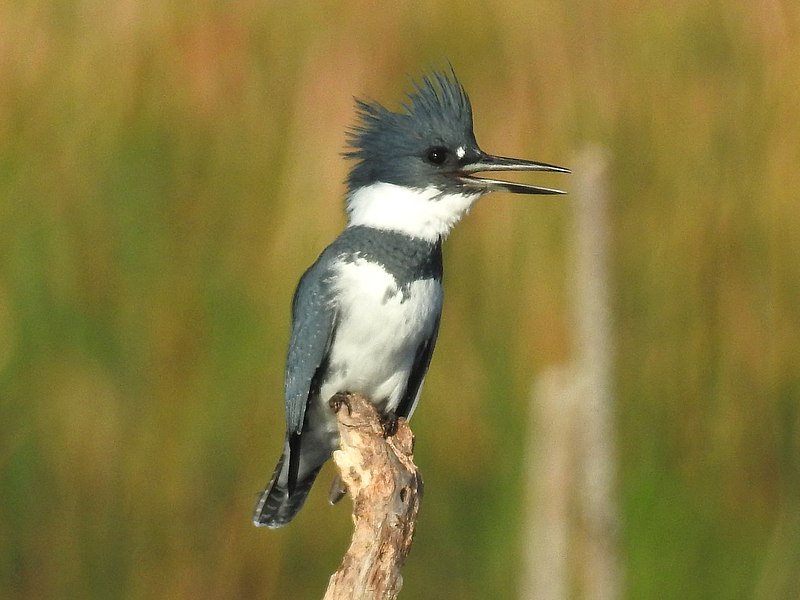
The belted kingfisher is a large, eye-catching bird native to North America. It belongs to the family Alcedinidae and has been divided into three subfamilies by recent research.
The species was first described in 1758 by Carl Linnaeus in his Systema Naturae.
This water Kingfisher stands out for its size as well as its striking plumage; males are bright blue on top with white below and females have rusty brown backs and wings with a thick black breast band across their chest.
They also possess an impressive call which can be heard from quite far away.
Belted kingfishers feed mainly on small fish but will sometimes also eat crustaceans, insects or even amphibians if they come across them while hunting around rivers or streams.
All in all, this is truly one remarkable bird that deserves our admiration.Scientific classification:
| Kingdom | Animalia |
| Phylum | Chordata |
| Class | Aves |
| Order | Coraciiformes |
| Family | Alcedinidae |
| Subfamily | Cerylinae |
| Genus | Megaceryle |
| Species | M. alcyon |
Also Featured In: Most Popular Bird Species in North America, Birds that Live around Central Florida
25. Brown-Headed Cowbird
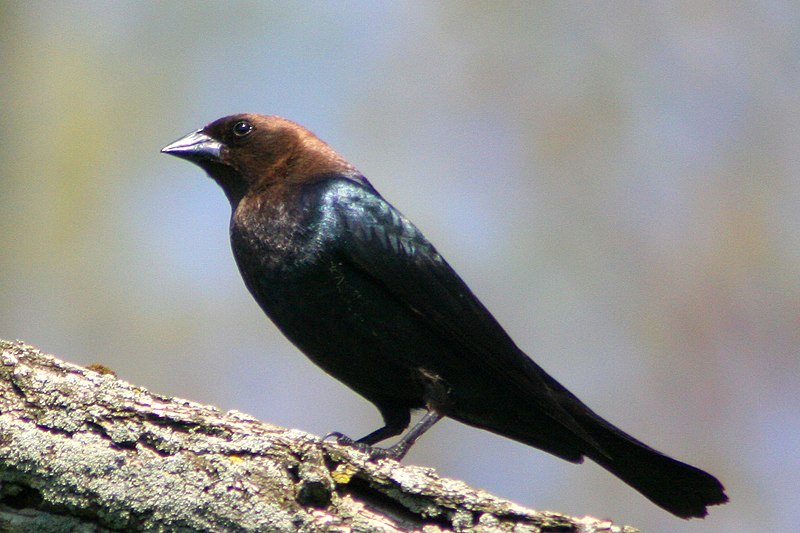
The Brown-headed Cowbird is a small, obligate brood parasitic icterid native to temperate and subtropical North America. It has a brown head with glossy black plumage on the body, wings and tail feathers.
During summer months it can be found in prairies, grasslands as well as open wooded areas but during winter they migrate southwards towards the United States of Mexico for warmer climate.
They are mainly insectivorous birds which feed on insects like caterpillars or beetles but also consume some grains too.
The female bird lays its eggs in nests of other species who then incubates them until hatching time thus leaving their own chicks uncared for by themselves.Scientific classification:
| Kingdom | Animalia |
| Phylum | Chordata |
| Class | Aves |
| Order | Passeriformes |
| Family | Icteridae |
| Genus | Molothrus |
| Species | M. ater |
Also Featured In: Birds that Live in Manitoba, Spring Birds that Live around Us
26. American White Pelican
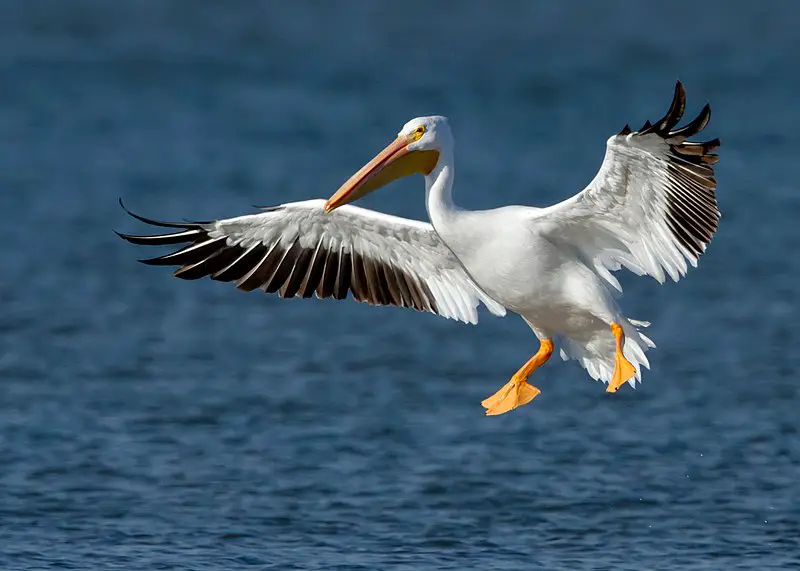
The American White Pelican is a majestic bird from the Pelecaniformes order, known for its impressive size and ability to soar gracefully in the sky.
It breeds during summer months in North America and migrates southwards towards Central and South America during winter.
The species was first described by German naturalist Johann Friedrich Gmelin back in 1789 as part of his updated version of Carl Linnaeus’ work.
This large aquatic bird has an all-white plumage with black primary flight feathers on its wings, while its beak features a characteristic yellowish colouration at the base near the face.
Its diet mainly consists of fish which it typically catches after dipping into water using its long bill; yet sometimes they can be seen stealing food items from other birds such as cormorants or gulls.Scientific classification:
| Kingdom | Animalia |
| Phylum | Chordata |
| Class | Aves |
| Order | Pelecaniformes |
| Family | Pelecanidae |
| Genus | Pelecanus |
| Species | P. erythrorhynchos |
Also Featured In: Birds You’ll Find in South Texas , Most Common Lake Birds
27. Great Horned Owl
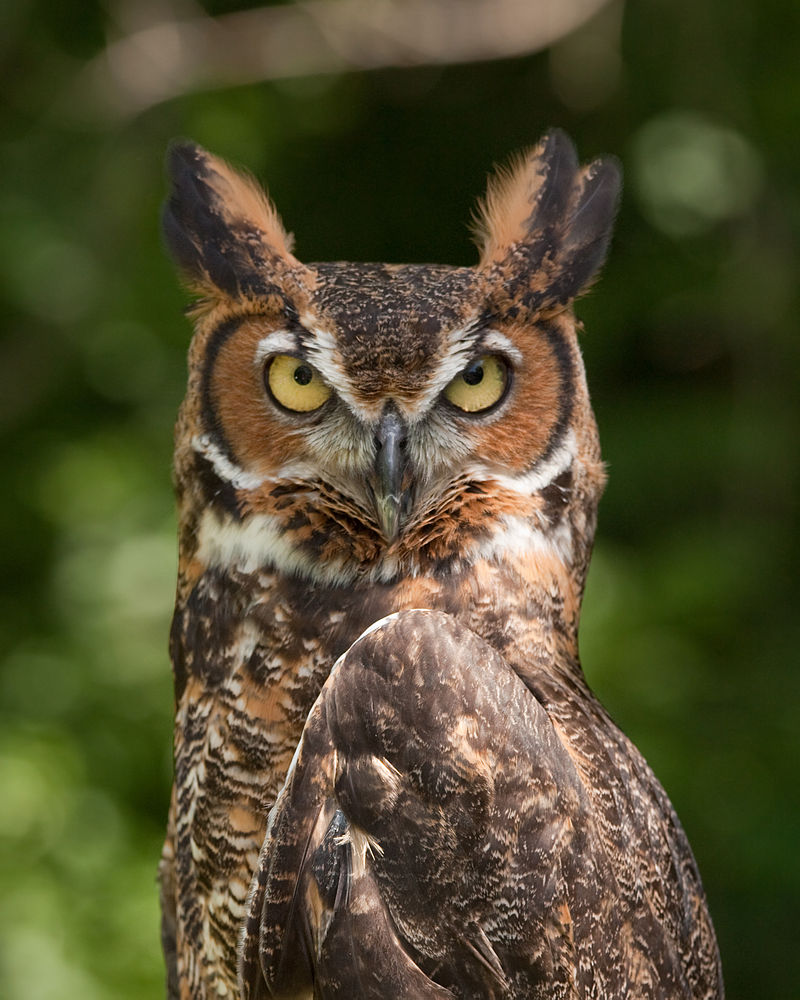
The Great Horned Owl is an impressive bird native to the Americas. It is well-known for its wide range and adaptability, as it can be found in many different habitats across the continent.
Its diet consists primarily of rabbits, hares, rats and mice; however, they are also known to consume skunks, geese and other birds too.
With their powerful talons capable of crushing prey with ease, these owls have earned themselves a fearsome reputation due to their incredible strength.
Their iconic horn-like tufts on either side of its head add another layer of intimidation which helps them stand out from other owls in the area.Scientific classification:
| Kingdom | Animalia |
| Phylum | Chordata |
| Class | Aves |
| Order | Strigiformes |
| Family | Strigidae |
| Genus | Bubo |
| Species | B. virginianus |
Also Featured In: Birds that Live in the Deserts, Birds You’ll Find in Night
28. Red-Breasted Nuthatch

The Red-breasted Nuthatch is a beautiful and vocal songbird that can be found in coniferous forests across Canada, Alaska, the northeastern United States and western US.
This small bird has blue-grey upperparts with cinnamon underparts, a white throat and face with black eye stripe, straight grey bill and black crown.
Its call sounds like a tin trumpet; it’s high-pitched yet nasal.
During mating season they form monogamous pairs to build their nest near tree trunks or branches at low heights off the ground where they lay 2 – 8 eggs at once.
They are very active little birds who love clinging to trees while searching for insect larvae or seeds within the bark of trees which helps control pest populations.Scientific classification:
| Kingdom | Animalia |
| Phylum | Chordata |
| Class | Aves |
| Order | Passeriformes |
| Family | Sittidae |
| Genus | Sitta |
| Species | S. canadensis |
Also Featured In: Common Birds in Canada, Acadia National Park Birds
29. Cardinal
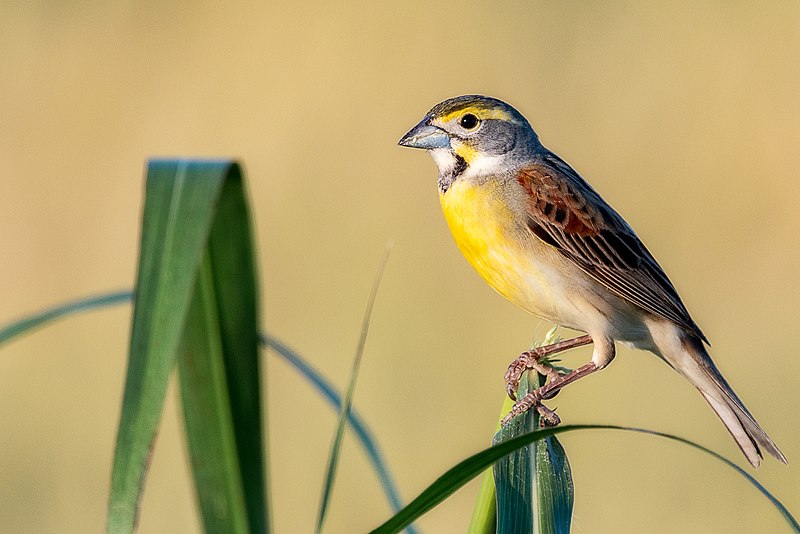
Cardinalidae is a family of passerine birds endemic to the New World that includes cardinals, grosbeaks and buntings.
This large group has great diversity in its members which range from tanager-like Piranga to warbler-like Granatellus.
They are usually distinguished by their bright plumage with reds, oranges and yellows being common among them.
Their strong bills enable them to feed on seeds, fruits and insects as well as other small prey items like lizards or frogs depending upon species.
Cardinals also have loud calls often used for territorial defense and courtship purposes while some can even imitate sounds made by other animals.
These adaptable birds inhabit a variety of habitats across North America making them an important part of many ecosystems there.Scientific classification:
| Kingdom | Animalia |
| Phylum | Chordata |
| Class | Aves |
| Order | Passeriformes |
| Superfamily | Emberizoidea |
| Family | Cardinalidae Ridgway, 1901 |
Also Featured In: Famous Paintings Birds, Spiritual Birds
30. Snowy Owl
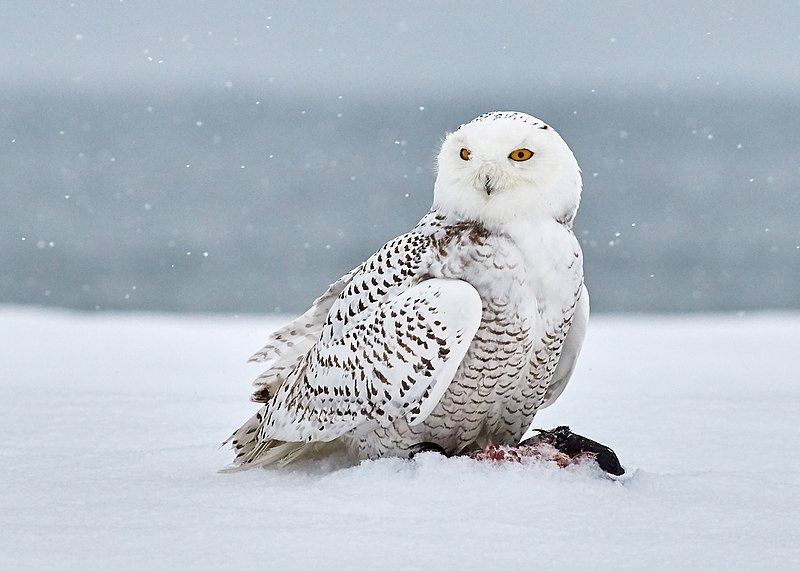
The Snowy Owl is an impressive bird of prey native to both the North American and Palearctic Arctic regions.
It has a unique white plumage that helps it blend in with its snowy tundra habitat, as well as several adaptations that make it suitable for life in cold climates.
These include thick feathers which insulate their bodies from frigid temperatures, large eyes adapted for hunting during long winter nights, and talons designed for gripping slippery surfaces such as ice or snow.
This majestic owl will soar high above its territory searching for food before gliding back down again to perch atop rocks or trees.
The Snowy Owl truly stands out amongst other birds of prey – an iconic symbol of the beauty and mystery of the north.Scientific classification:
| Kingdom | Animalia |
| Phylum | Chordata |
| Class | Aves |
| Order | Strigiformes |
| Family | Strigidae |
| Genus | Bubo |
| Species | B. scandiacus |
Also Featured In: Tundra Birds, Birds of Taiga
31. White-Throated Sparrow

The White-throated Sparrow is a small passerine bird of the New World sparrow family Passerellidae.
It has distinctive yellow and black stripes on its head, white throat and chest with grey back and wings, along with light brown legs.
The scientific name “Zonotrichia albicollis” comes from Ancient Greek for ‘band’ (ζώνη) referring to its distinctive striped crown, and Latin for ‘white neck’ (albus collum).
These birds are usually found in wooded areas such as coniferous forests or deciduous habitats in North America where they feed mainly on insects during summer months; transitioning to seeds during winter.
They build their nests near ground level using grasses, twigs or moss lined with feathers.
White-throated Sparrows may be solitary but also form flocks when migrating southward each fall season which typically occurs over mid-late October through November depending on location within range.Scientific classification:
| Kingdom | Animalia |
| Phylum | Chordata |
| Class | Aves |
| Order | Passeriformes |
| Family | Passerellidae |
| Genus | Zonotrichia |
| Species | Z. albicollis |
Also Featured In: Yellow Georgia Birds, Large New Hampshire Birds
32. Song Sparrow

The Song Sparrow (Melospiza melodia) is a small, yet abundant bird found in North America.
They have brown upperparts with dark streaks and are white underneath, complete with a distinct dark brown spot on the breast.
Their cap is also brown and long roughed feathers can be seen sprouting from their neck area.
This sparrow species is highly variable and adaptable to many different environments including dry brush land, wetlands or open fields.
It has been noted that adult song sparrows will sing even during winter months when other birds remain quiet.
These energetic little animals make for great backyard companions as they flit about singing their lovely melodies.Scientific classification:
| Kingdom | Animalia |
| Phylum | Chordata |
| Class | Aves |
| Order | Passeriformes |
| Family | Passerellidae |
| Genus | Melospiza |
| Species | M. melodia |
Also Featured In: Common Winter Birds of New Brunswick, Brown Birds of Florida
33. Ruby-Throated Hummingbird

The ruby-throated hummingbird (Archilochus colubris) is a species of hummingbird that has an impressive migration pattern, spending the winter in Central America, Mexico and Florida before flying to Canada and other parts of Eastern North America for breeding season.
It’s by far the most common type seen east of the Mississippi River in North America.
Formally described by Swedish naturalist Carl Linnaeus in 1758, this tiny bird has bright metallic green upperparts with white underparts, a small black bill and a red throat patch which gives it its name; they measure around 3 inches long on average.
They feed primarily on nectar from flowers but also eat insects such as flies or mosquitoes for extra protein during their migrations or when raising young chicks.Scientific classification:
| Kingdom | Animalia |
| Phylum | Chordata |
| Class | Aves |
| Order | Apodiformes |
| Family | Trochilidae |
| Genus | Archilochus |
| Species | A. colubris |
Also Featured In: Georgia Birds, Red Minnesota Birds You Need to Know
34. Red-Headed Woodpecker
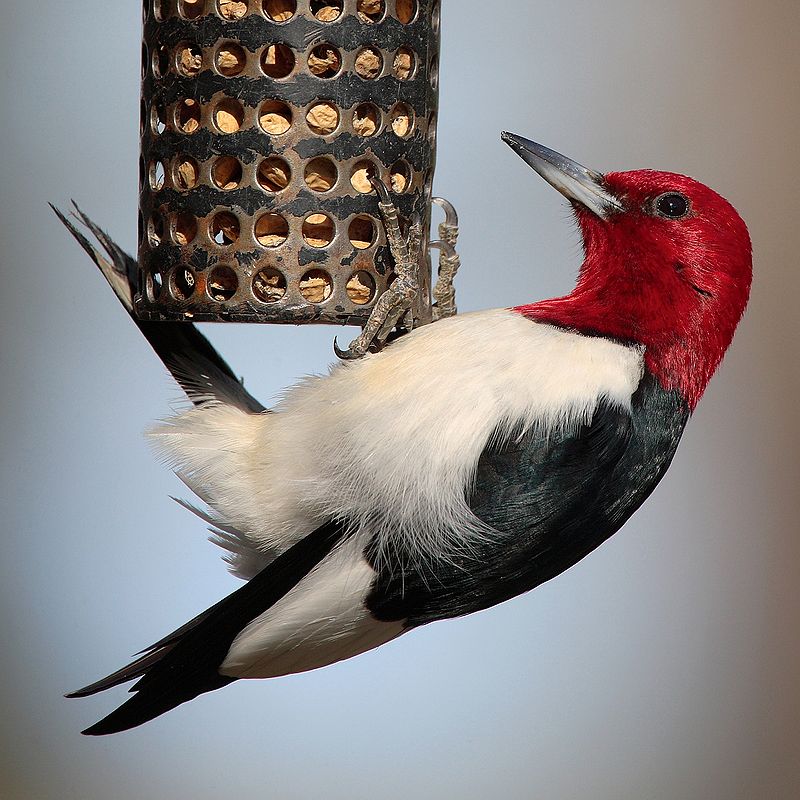
The red-headed woodpecker is a mid-sized bird found in temperate North America. It has striking plumage, with its head and neck being bright red while the rest of its body is primarily black and white.
Its wings are rounder than other similar species, allowing it to maneuver through tight spaces easily when searching for food or shelter.
The breeding habitat of this bird consists mainly of open fields across Canada and the east-central United States.
Despite facing threats such as deforestation, urbanization, predation from larger birds, collisions with windows or cars due to their inquisitive nature.
These birds remain listed on IUCN’s Red List as least concern thanks largely in part to conservation efforts by local governments and organizations dedicated to protecting wildlife habitats.Scientific classification:
| Kingdom | Animalia |
| Phylum | Chordata |
| Class | Aves |
| Order | Piciformes |
| Family | Picidae |
| Genus | Melanerpes |
| Species | M. erythrocephalus |
Also Featured In: Red Birds You’ll Commonly Found in Texas, Red Birds that Live in Tennessee
35. Ruby-Crowned Kinglet
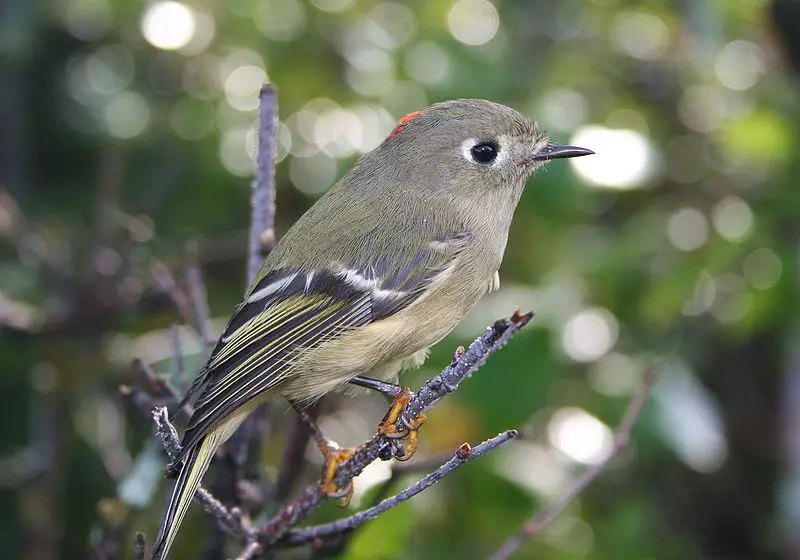
The Ruby-crowned Kinglet is a small passerine bird native to North America. It has olive green plumage, white wing bars and an eye-ring as well as a distinctive red crown patch on the males.
Juveniles look similar to adults with no distinguishing features other than size.
They are usually found in coniferous forests or woodlands where they spend much of their time searching for insects among foliage and branches while constantly flitting from place to place.
These birds have incredible energy levels that allow them to travel long distances during migration season without getting exhausted too quickly, making them one of nature’s most resilient species.Scientific classification:
| Kingdom | Animalia |
| Phylum | Chordata |
| Class | Aves |
| Order | Passeriformes |
| Family | Regulidae |
| Genus | Corthylio Cabanis, 1853 |
| Species | C. calendula |
Also Featured In: Central Texas Birds, Birds You’ll Find in the Rio Grande Valley
36. Indigo Bunting
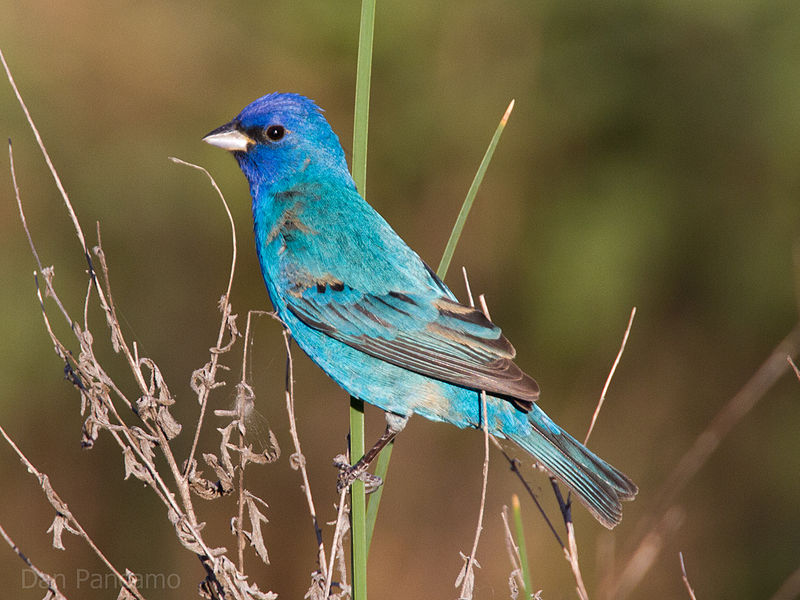
The Indigo Bunting is a small bird in the cardinal family, found throughout North and South America.
It has an unmistakable bright blue plumage that stands out against its natural habitat of farmland, brush areas and open woodland.
During breeding season it can be seen from southern Canada to northern Florida while during winter months it migrates south towards Central and Northern South America.
The Indigo Bunting prefers to migrate at night using the stars as navigation aids.
This species feeds on insects and seeds which they find near the ground or catch mid-flight with their agile wingspan.
An iconic sight for many farmers across both continents, these birds are a welcome addition to any backyard oasis or wildflower meadow.Scientific classification:
| Kingdom | Animalia |
| Phylum | Chordata |
| Class | Aves |
| Order | Passeriformes |
| Family | Cardinalidae |
| Genus | Passerina |
| Species | P. cyanea |
Also Featured In: Small Birds that Commonly Found in Ohio, Small Birds of Pennsylvania
37. Eastern Screech Owl
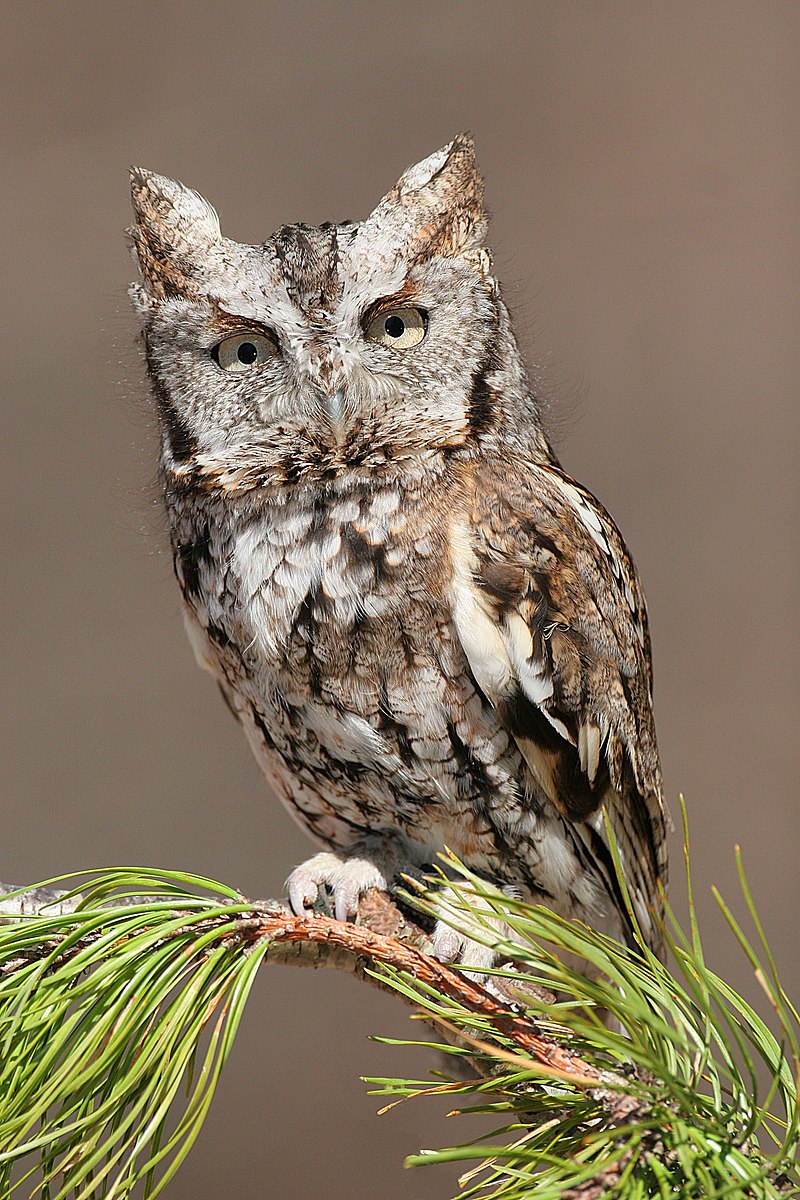
The Eastern screech owl is a small nocturnal bird native to most wooded areas in Mexico and Canada. It has adapted well to human development, making it relatively common in East North America.
This species is known for its unique call which often sounds like a horse whinnying or an electronic beep.
Its feathers are mainly grey with brown bars, but they can also range from red-brown to blackish-grey depending on the individual bird’s location.
They feed primarily on insects and other small animals such as mice and lizards that live near their nest sites at night.
The eastern screech owl is an amazing creature adapting well to humans while still managing to stay hidden under cover of darkness.Scientific classification:
| Kingdom | Animalia |
| Phylum | Chordata |
| Class | Aves |
| Order | Strigiformes |
| Family | Strigidae |
| Genus | Megascops |
| Species | M. asio |
Also Featured In: Small Birds of Texas, Small Birds Of Illinois
38. Cooper’s Hawk
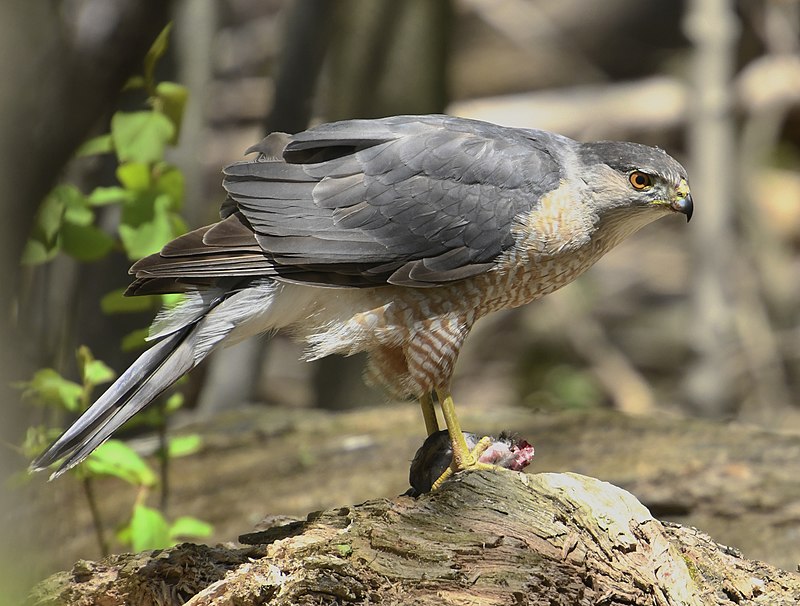
Cooper’s Hawk is a medium-sized bird of prey native to North America. It belongs to the Accipiter genus, which are known for their agility and small size compared to other hawks.
They usually inhabit wooded areas, making them well-adapted hunters in dense environments.
Cooper’s Hawks have rounded wings with short tails that help them maneuver quickly through trees when chasing after prey such as small rodents or birds.
These raptors also possess powerful feet equipped with sharp talons used for catching food items on the ground and even out of midair.
The adult plumage has barred upperparts, ranging from greyish brown on lighter individuals up to dark chestnut colors found in darker specimens; they also display rusty underparts marked by thin white streaking down either side of their chests and bellies.Scientific classification:
| Kingdom | Animalia |
| Phylum | Chordata |
| Class | Aves |
| Order | Accipitriformes |
| Family | Accipitridae |
| Genus | Accipiter |
| Species | A. cooperii |
Also Featured In: Winter Birds of Ohio, Most Common Birds of Staten Island
39. Snow Bunting
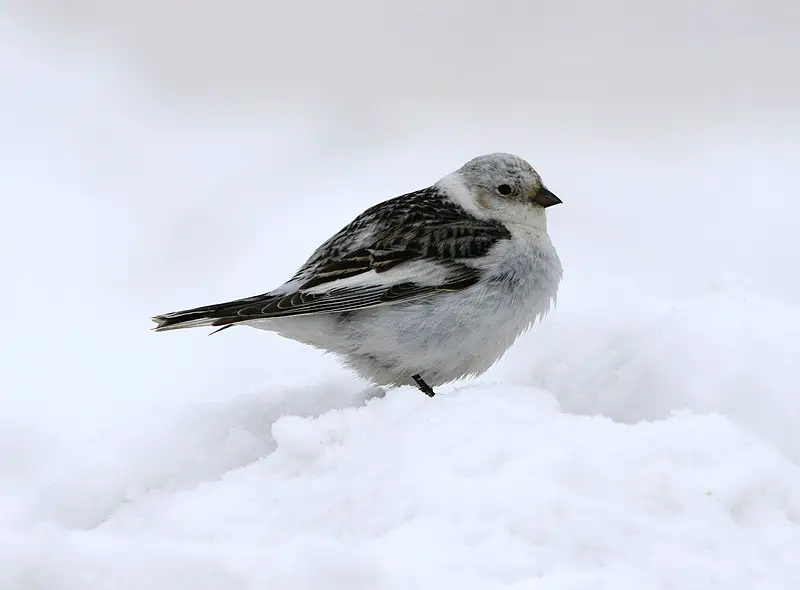
The snow bunting is a small and colourful passerine bird found in the Arctic regions of the northern hemisphere.
With its bright white feathers, black markings on its wings and tail, it stands out amongst other birds that inhabit these cold climates.
This species has adapted well to surviving in this harsh environment; they nest under boulders or rocks so their eggs are shielded from predators and blizzards alike.
They feed mainly on insects during summer months but switch to seeds when winter arrives as they seek food sources which will not freeze over with ice.
The snow bunting is an important part of the local ecosystem due to providing sustenance for larger animals such as foxes and owls who rely upon them for survival throughout wintertime.Scientific classification:
| Kingdom | Animalia |
| Phylum | Chordata |
| Class | Aves |
| Order | Passeriformes |
| Family | Calcariidae |
| Genus | Plectrophenax |
| Species | P. nivalis |
Also Featured In: Iceland birds, Birds Found in Hungary
40. Brown Creeper
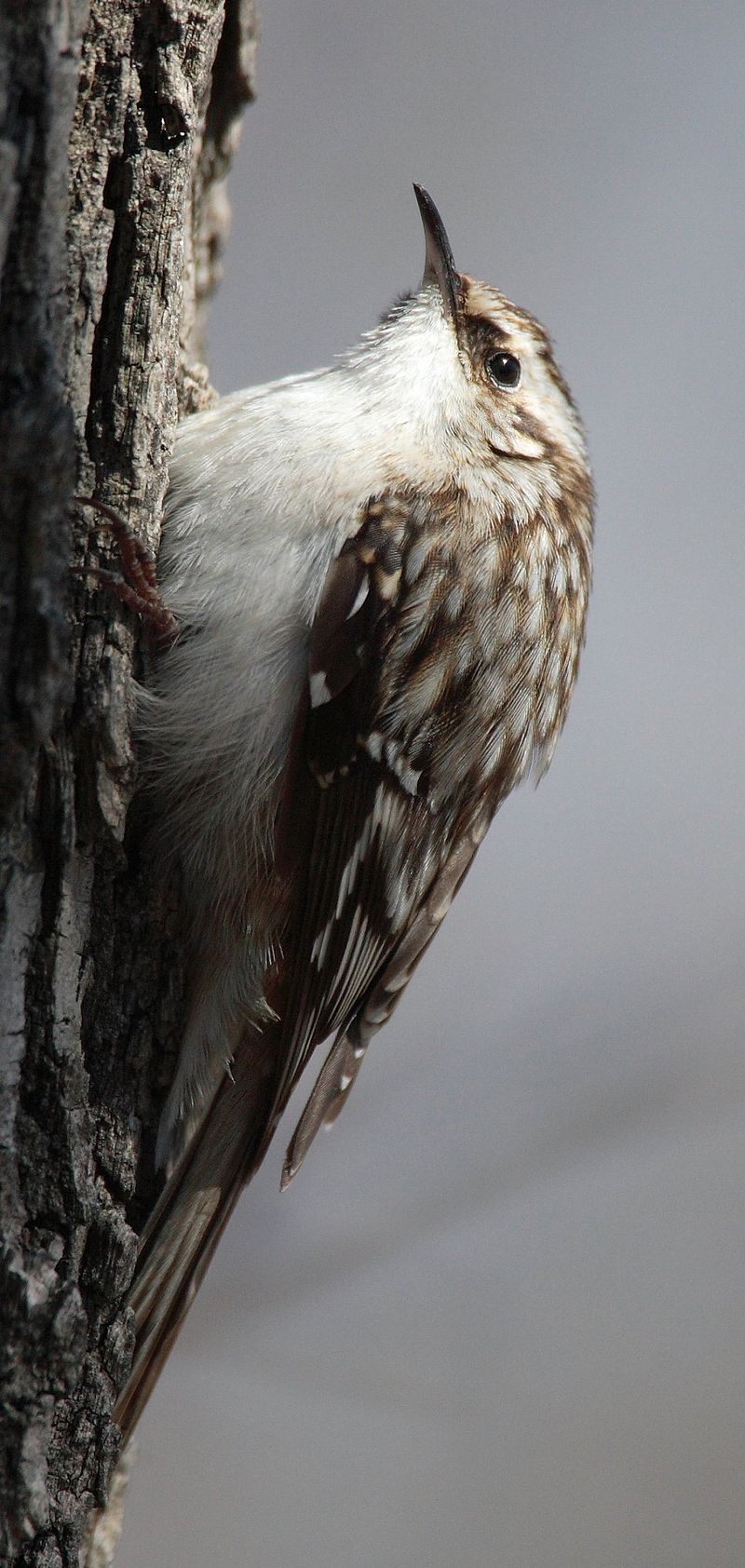
The Brown Creeper is a small songbird belonging to the Certhiidae family and is native to North America. It has brown upperparts with light spotting that resembles tree bark, as well as white underparts.
Its bill is long and thin with a slight downward curve while its tail is also long yet stiff; this helps it creep up trees.
This bird feeds mainly on insects which can be found in crevices of barks or dead plants, thanks to its curved bill which allows it access these hard-to-reach places.
When searching for food they move diagonally upwards around trunks so their camouflage blends in perfectly with the background making them difficult to spot.Scientific classification:
| Kingdom | Animalia |
| Phylum | Chordata |
| Class | Aves |
| Order | Passeriformes |
| Family | Certhiidae |
| Genus | Certhia |
| Species | C. americana |
Also Featured In: Chickadees Birds, New Hampshire Birds You Should Know
41. Common Redpoll
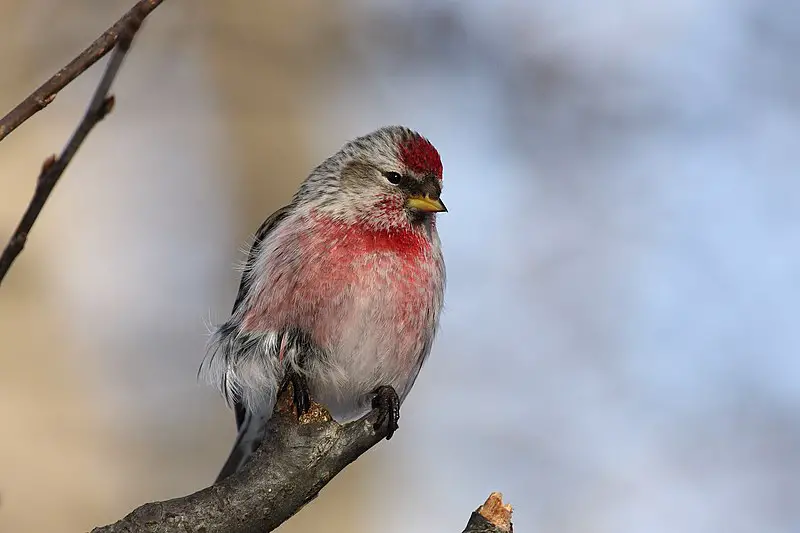
The Common Redpoll is a species of bird belonging to the finch family. It has an orange-red crown, white breast and grey back with two black stripes running down either side.
Its wings are barred in browns and its tail feathers have a grayish tinge at their tips. The redpoll breeds mainly south from Arctic regions in habitats that contain shrubs or thickets.
First classified by Linnaeus in 1758 under the binomial name Fringilla flammea, it’s genus Acanthis originates from Ancient Greek akantha meaning “thorn” or “prickle”.
This small yet colourful bird feeds mainly on seeds such as thistles during summer months but switches over to birch catkins when winter arrives – making them a common sight throughout much of North America and Eurasia.Scientific classification:
| Kingdom | Animalia |
| Phylum | Chordata |
| Class | Aves |
| Order | Passeriformes |
| Family | Fringillidae |
| Subfamily | Carduelinae |
| Genus | Acanthis |
| Species | A. flammea |
Also Featured In: Finches Species, Most Common Winter Birds
42. Pine Siskin
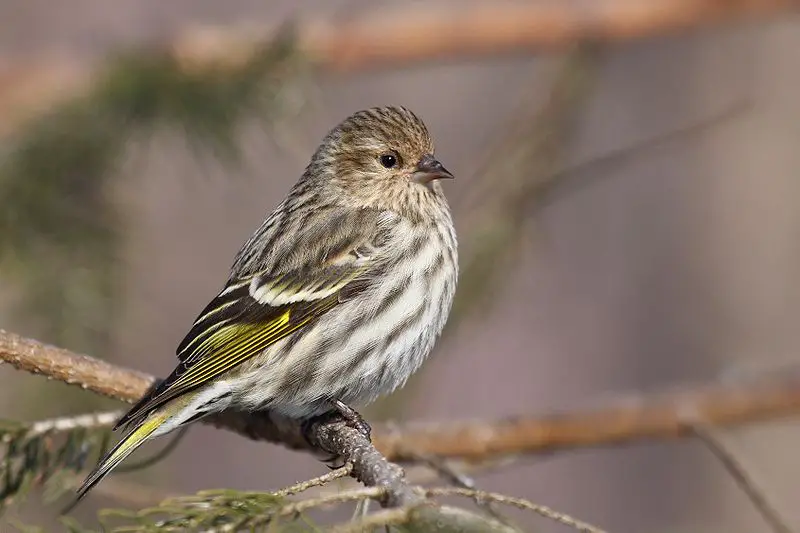
The Pine Siskin is a small bird from the finch family, primarily found in North America. It has an irregular migratory range and was first described by American ornithologist Alexander Wilson in 1810.
The species gets its name pinus, which means “pine-tree” in Latin, due to its frequent presence near coniferous trees.
Pine siskins are known for their yellow wing bars and streaked chests as well as their perky mannerisms when perched on branches or flying around looking for food during colder months.
They feed mostly on seeds of weeds, grasses and other plants but can also be seen consuming insects at times during summertime nesting season.
Its loud calls often alert nearby birds of potential danger while they nest high up among pine tree limbs where predators cannot reach them easily.Scientific classification:
| Kingdom | Animalia |
| Phylum | Chordata |
| Class | Aves |
| Order | Passeriformes |
| Family | Fringillidae |
| Subfamily | Carduelinae |
| Genus | Spinus |
| Species | S. pinus |
Also Featured In: Autumn Birds You Should Know, Common Birds in Saskatchewan
43. Two-Barred Crossbill
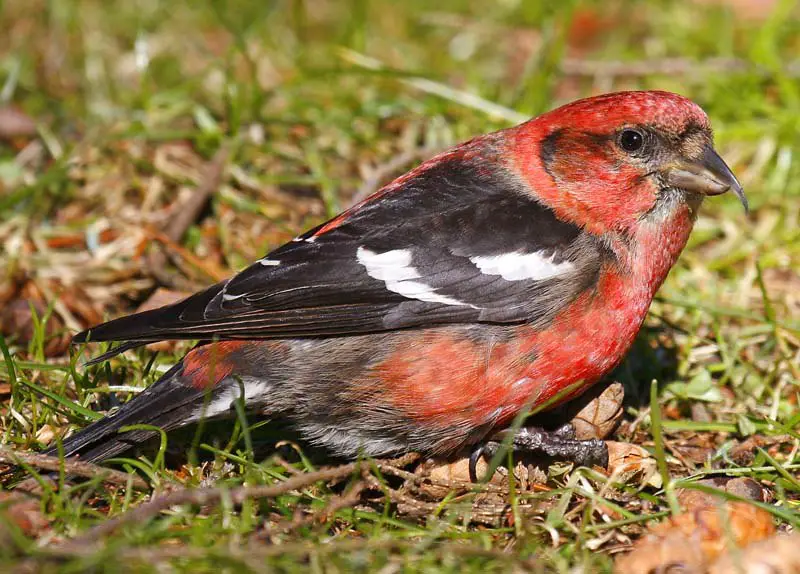
The Two-barred crossbill is a small passerine bird belonging to the finch family Fringillidae.
It gets its scientific name, Loxia leucoptera, from Ancient Greek – with ‘Loxia’ meaning ‘crosswise’ and ‘leucoptera’ translating to “white-winged” in reference to its white wings.
The species has two subspecies: the white-winged crossbill (Loxia leucoptera leucoptera) that can be found in North America and the two bar crossbill (Loxia leucocephala) which inhabits Europe, Asia as well as parts of northern Africa.
These birds feed mainly on conifer seeds but have also been seen consuming insects such as beetles or caterpillars during breeding season when food resources are scarce for their young ones.
They construct nests made out of twigs near trunks of spruce trees where they lay 2–6 eggs at one time.Scientific classification:
| Kingdom | Animalia |
| Phylum | Chordata |
| Class | Aves |
| Order | Passeriformes |
| Family | Fringillidae |
| Subfamily | Carduelinae |
| Genus | Loxia |
| Species | L. leucoptera |
Also Featured In: Birds that Migrate through Illinois in the Spring, Common Birds in Alberta
44. American Tree Sparrow
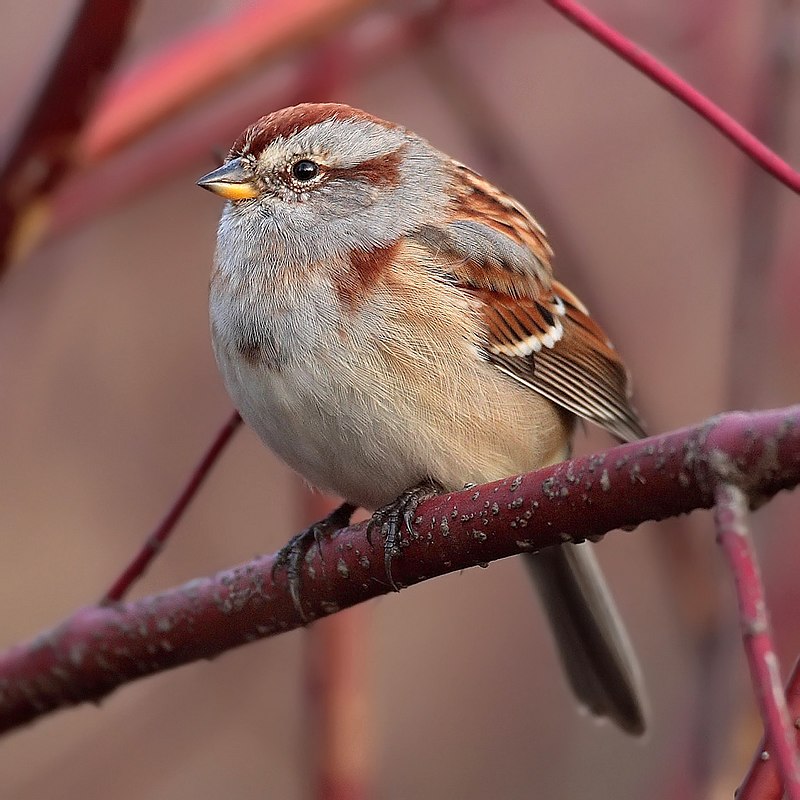
The American tree sparrow, also known as the winter sparrow, is a medium-sized New World bird. It has an attractive rusty cap and grey underparts with a small dark spot on its chest.
Its back is rust colored and striped with lighter shades of brown while its wings have various shades of browns.
These birds are usually found in open areas such as grasslands or marshland during spring migration and can form large flocks when seeking food sources like seeds, insects or berries.
They nest in shrubs or trees near water sources but rarely do so far away from human settlements due to their dependence on supplementary foods provided by humans.
The American Tree Sparrow is a delightful sight for any nature enthusiast.Scientific classification:
| Kingdom | Animalia |
| Phylum | Chordata |
| Class | Aves |
| Order | Passeriformes |
| Family | Passerellidae |
| Genus | Spizelloides Slager & Klicka, 2014 |
| Species | S. arborea |
Also Featured In: Sparrows Species, Birds Commonly Found in New York
45. Tree Swallow
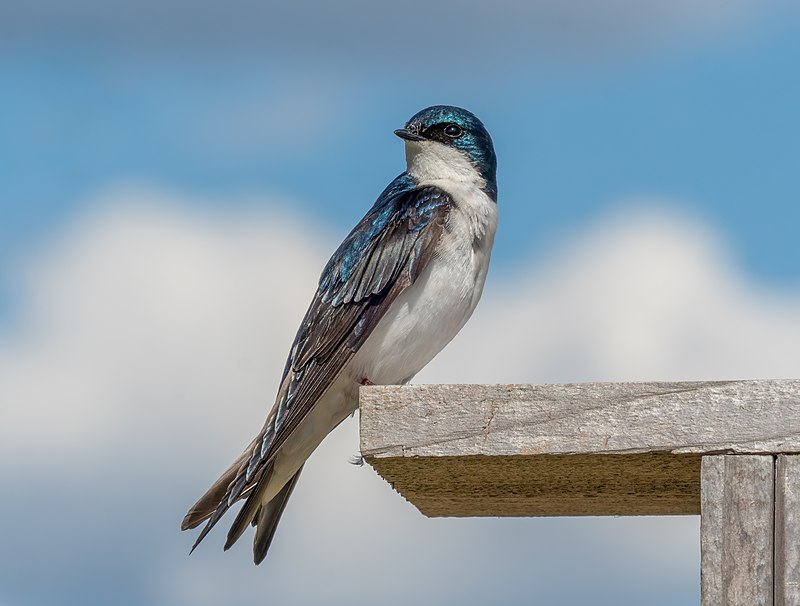
The Tree Swallow is a migratory bird of the Hirundinidae family, first described by French ornithologist Louis Vieillot in 1807. It has glossy blue-green upperparts, and white underparts with iridescent violet on its throat and breast.
Its wings are blackish above with pale grey below, while its tail feathers are blackish-blue with white edges.
During breeding season they build cup shaped nests out of grasses or twigs which are lined with animal hair or fur found near their nesting sites.
They feed mainly on insects such as flies and beetles that they catch while flying over fields or water surfaces during summer months when food is abundant for them to survive migration back southward in winter time.
The tree swallow is an important part of our environment both aesthetically and ecologically due to it’s insectivorous diet helping keep pest populations low in certain areas where agricultural crops may otherwise be damaged without these birds around.Scientific classification:
| Kingdom | Animalia |
| Phylum | Chordata |
| Class | Aves |
| Order | Passeriformes |
| Family | Hirundinidae |
| Genus | Tachycineta |
| Species | T. bicolor |
Also Featured In: Swallows Species, Blue Birds You’ll Found around Us
46. Purple Martin
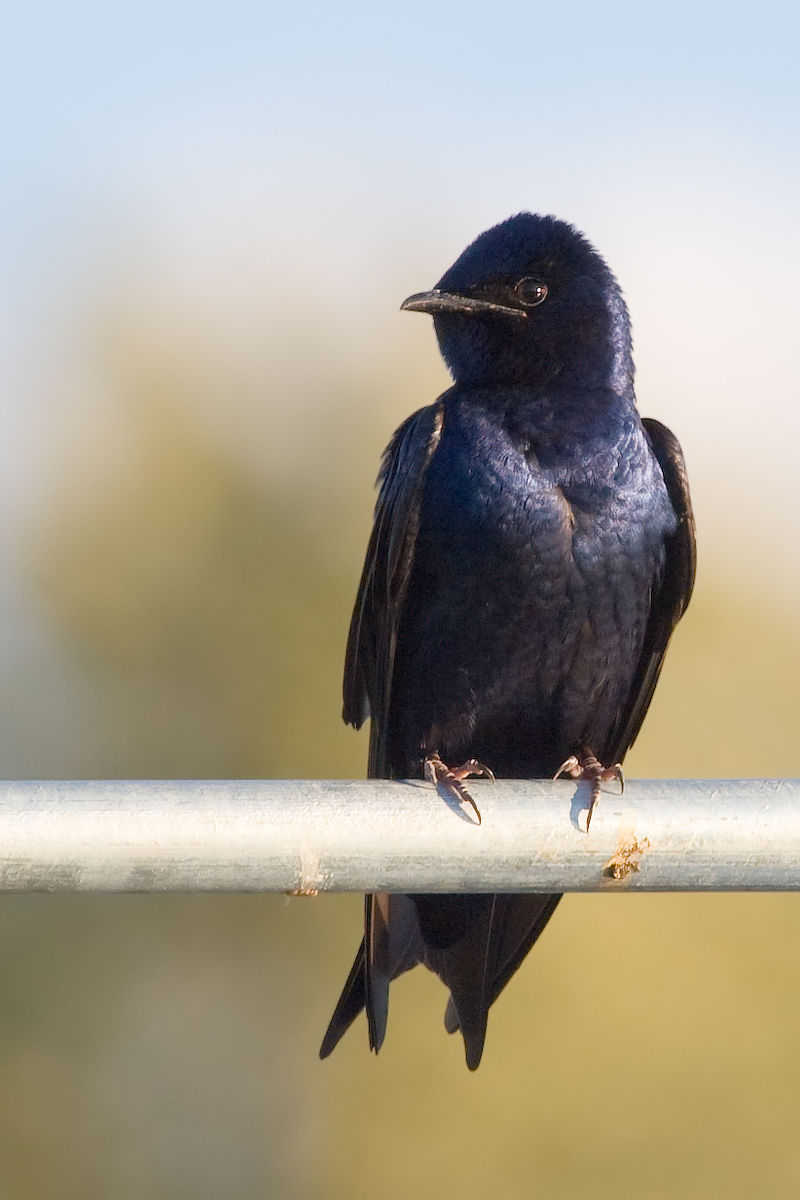
The Purple Martin is a beautiful passerine bird in the swallow family, and is the largest of its kind in North America.
It has dark blackish-blue feathers that have an iridescent sheen which can make them appear blue or deep purple depending on the light; they may even look green.
These birds are quite social creatures and often build communal roosts with multiple nests, having as many as hundreds of individuals living together at once.
They feed mainly on flying insects such as flies, moths, wasps and bees.
Their habitats include areas near bodies of water like lakes or rivers where there’s plenty for these birds to eat all year round.
The Purple Martin is truly an amazing species worth protecting.Scientific classification:
| Kingdom | Animalia |
| Phylum | Chordata |
| Class | Aves |
| Order | Passeriformes |
| Family | Hirundinidae |
| Genus | Progne |
| Species | P. subis |
Also Featured In: Birds That Live in Colorado, Magenta Birds You Didn’t Know
47. American Yellow Warbler
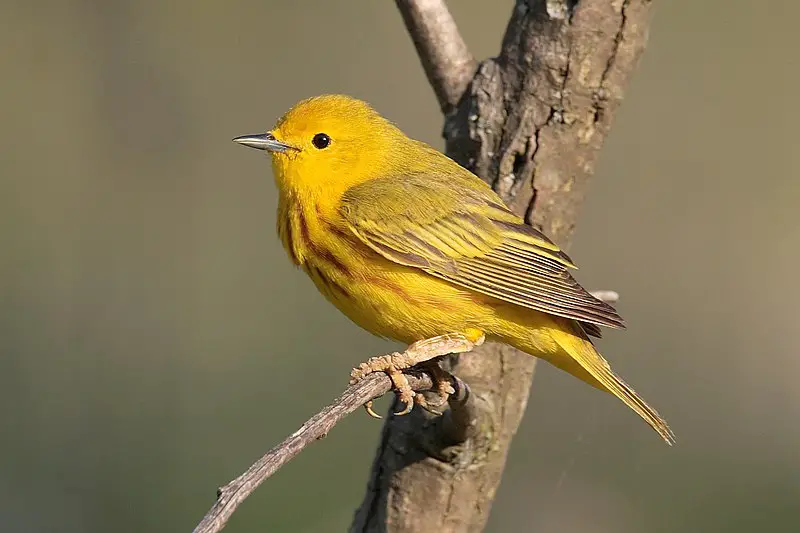
The American Yellow Warbler (Setophaga petechia) is a species of New World warbler found across North America, the Caribbean and into northern South America.
Its genus name Setophaga comes from Ancient Greek words meaning “moth” and “eating”, while its specific name Petechia originates from Italian for small red spots.
This bird has striking yellow plumage with reddish-brown streaks on their chest that can be seen during mating season when they are most colourful.
They live in open woodlands near wetlands or bodies of water where they can find food such as insects like spiders, beetles and caterpillars which make up much of their diet.
The male will sing to attract a mate during breeding season before setting up home in twig nests built by both sexes together high in trees or shrubs.Scientific classification:
| Kingdom | Animalia |
| Phylum | Chordata |
| Class | Aves |
| Order | Passeriformes |
| Family | Parulidae |
| Genus | Setophaga |
| Species | S. petechia |
Also Featured In: Utah Birds, Most Common Songs Birds that Live around You
48. Rose-Breasted Grosbeak
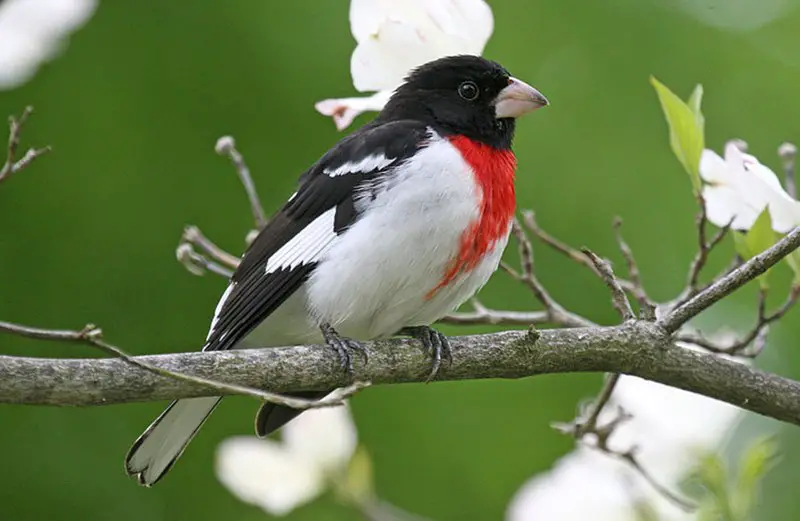
The Rose-breasted Grosbeak is a large, brightly coloured bird belonging to the Cardinal family. Males have black heads and wings, with white breasts boasting a bright rose patch.
Females are more muted in colouring being mostly buffy brown or greyish overall but still featuring the distinctive rose breast patch.The two sexes also exhibit marked sexual dimorphism.
These birds inhabit open woodlands across North America where they feed on seeds gleaned from foliage as well as fruits such as cherries and blueberries during their breeding season which runs from April through August each year.Scientific classification:
| Kingdom | Animalia |
| Phylum | Chordata |
| Class | Aves |
| Order | Passeriformes |
| Family | Cardinalidae |
| Genus | Pheucticus |
| Species | P. ludovicianus |
Also Featured In: Nebraska Birds, Summer Birds that Live around Us
49. Horned Lark
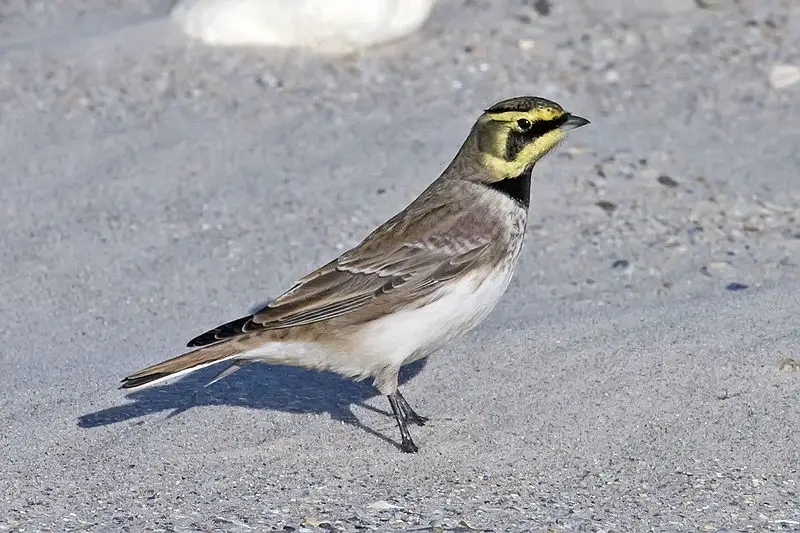
The Horned Lark, known as the Shore Lark in Europe and North America, is a species of lark belonging to the family Alaudidae.
It can be found across the northern hemisphere and has been classified under its Latin name Eremophila alpestris which means “of high mountains”, referring to its prevalence in mountainous areas like the Alps.
This bird is distinguished by two black tufts or ‘horns’ on either side of its head. Its size varies from 11-13 cm long with brown upperparts and pale whitish underparts sporting darker streaks throughout them both.
With an adaptation for ground nesting, it builds nests out of grasses lined with feathers near open fields where food sources are abundant such as insects, grains and seeds giving this species great potential for survival even when conditions may become harsh during winter months.Scientific classification:
| Kingdom | Animalia |
| Phylum | Chordata |
| Class | Aves |
| Order | Passeriformes |
| Family | Alaudidae |
| Genus | Eremophila |
| Species | E. alpestris |
Also Featured In: birds of Vermont, Ukrainian Birds You Should Know
50. Northern Flicker

The Northern flicker is a woodpecker species found in North America, Central America, Cuba, and the Cayman Islands. This medium-sized bird is known for its unique migration behavior.
Over 100 common names are used to refer to the Northern flicker, one of them being “yellowhammer”. It is a beautiful bird with distinctive markings and a colorful plumage.
The Northern flicker is an important species in its ecosystem and plays a key role in maintaining a healthy balance in the environment.
Despite being a woodpecker, the Northern flicker has a diverse diet that includes insects, fruits, and seeds.
It is fascinating to observe this bird as it pecks at trees in search of food, communicates with its unique vocalizations and performs its incredible aerial displays.
The Northern flicker is truly a remarkable bird species that is worthy of our admiration and protection.Scientific classification:
| Kingdom | Animalia |
| Phylum | Chordata |
| Class | Aves |
| Order | Piciformes |
| Family | Picidae |
| Genus | Colaptes |
| Species | C. auratus |
Also Featured In: Birds Live in Arkansas, Common Birds in the Cities
51. Northern Shrike
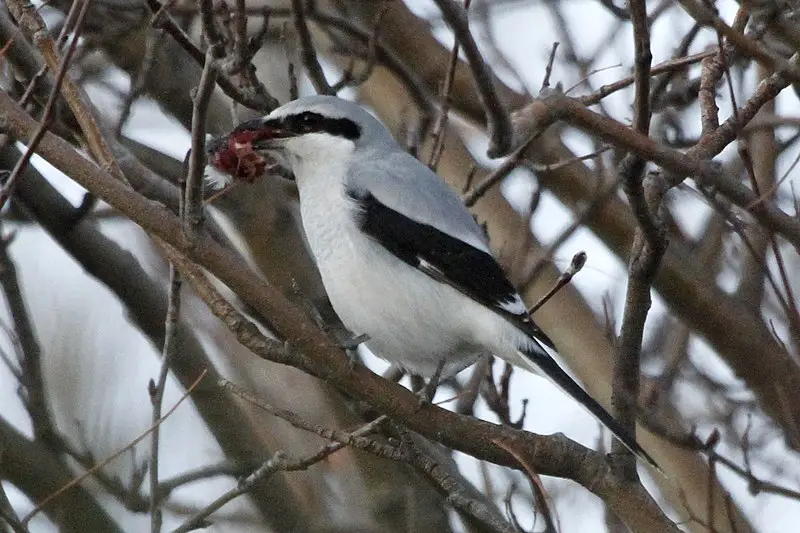
The northern shrike, also known as Lanius borealis, is a songbird species categorized under the shrike family. It is native to North America and Siberia and was previously classified as a subspecies of the great grey shrike.
However, it was recognized as a distinct species in 2017. Currently, there are six identified subspecies of the northern shrike.
This bird species was officially described by Louis Jean Pierre Vieillot, a French ornithologist, in 1808.
It is a relatively large bird with a fascinating predatory behavior of impaling its prey on thorns or barbed wire fences.
The northern shrike’s popularity in birdwatching is due to its striking appearance with a black mask and grayish-brown back and wings.Scientific classification:
| Kingdom | Animalia |
| Phylum | Chordata |
| Class | Aves |
| Order | Passeriformes |
| Family | Laniidae |
| Genus | Lanius |
| Species | L. borealis |
Also Featured In: Birds in Calgary You’ll Love to See, Birds You’ll Find in Vancouver Island